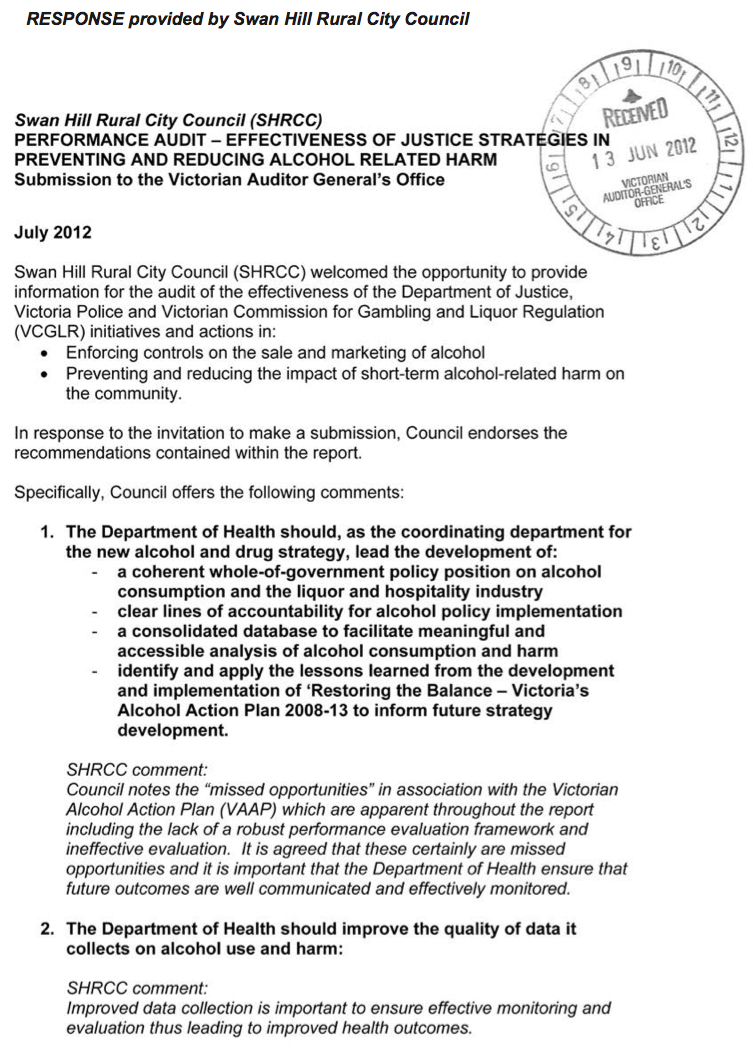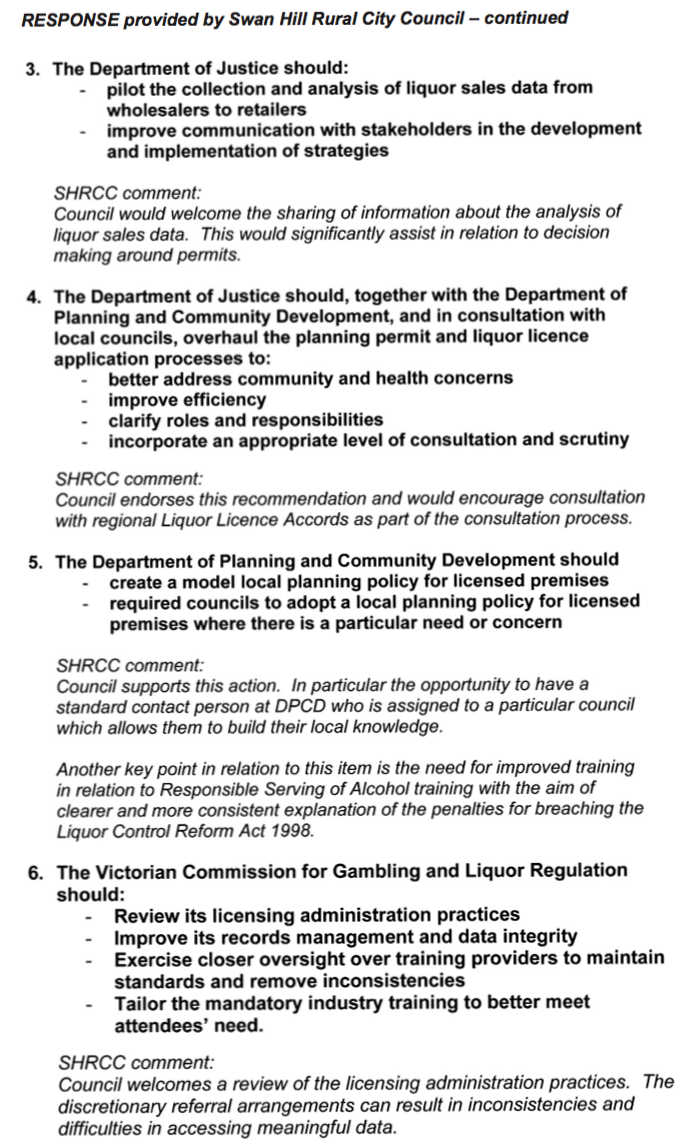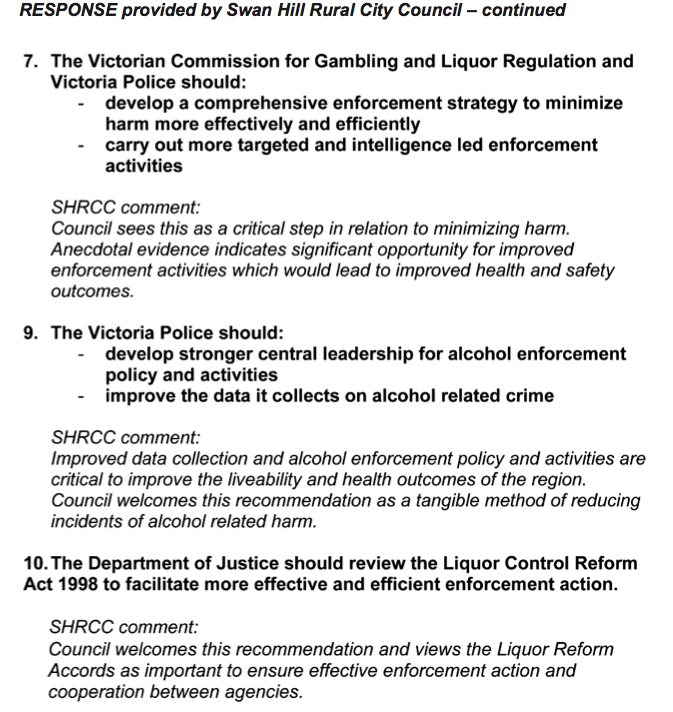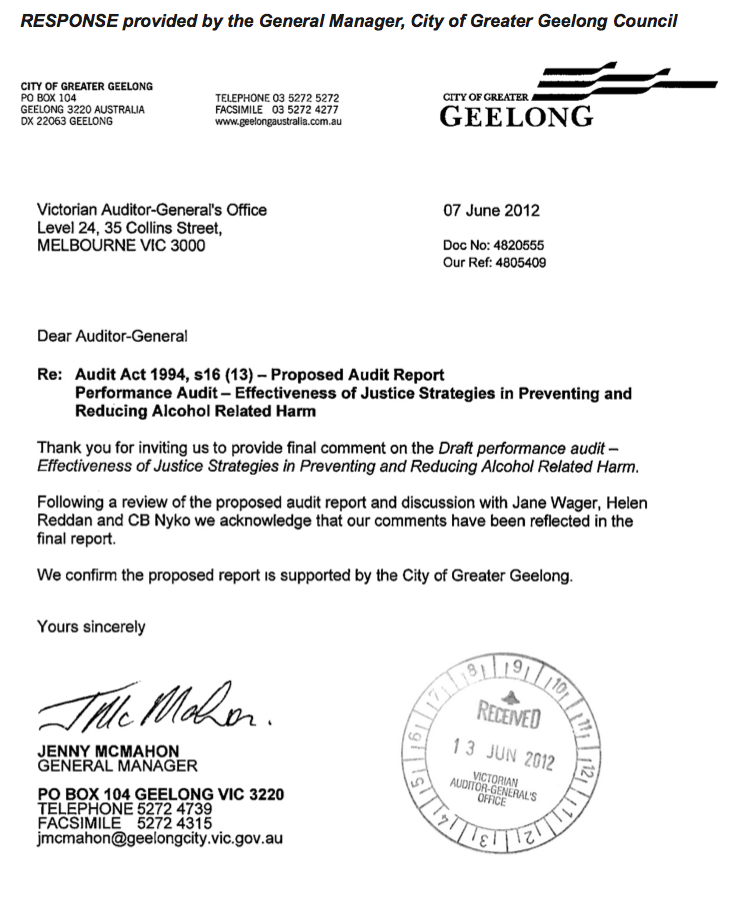Effectiveness of Justice Strategies in Preventing and Reducing Alcohol-Related Harm
Overview
The audit assessed the effectiveness of the Department of
Justice, Victoria Police and the Victorian Commission for Gambling
and Liquor Regulation in preventing and reducing the impact of
alcohol-related harm on the community.
Alcohol-related harm costs Victoria an estimated $4.3 billion per
year.
Despite the implementation of various strategies and
initiatives, the level of reported alcohol-related harm has
increased significantly over the past 10 years.
Harm minimisation efforts have been hampered by the lack of a
whole-of-government policy position on the role of alcohol in
society, by poorly chosen, implemented and evaluated initiatives,
by inconsistent and cumbersome liquor licensing processes and
legislation, and by a lack of coordinated, intelligence-led and
targeted enforcement.
The Department of Justice's initiatives to prevent and reduce alcohol-related harm were fragmented, superficial and reactive instead of targeted, evidence-based, complementary and well coordinated.
The liquor licensing regime is not effectively minimising alcohol-related harm. This is due to a lack of transparency in decision-making, insufficient guidance on regulatory processes, administrative errors, poor quality data and a lack of engagement from councils.
There is no overarching whole-of-government enforcement strategy to comprehensively address unlawful supply, particularly service to intoxicated patrons and minors, which is the cause of much alcohol-related harm. Inaccurate and incomplete data is further hampering enforcement efforts.
A fundamental change in approach to strategy development, licensing and enforcement is required before any noticeable impact on reducing harm is likely.
Audit summary
Background
Alcohol is a widely accepted part of Australian culture and generates positive impacts for the state in the form of revenue and employment. The number of liquor licences has more than doubled since the Liquor Control Reform Act 1998 was introduced. There are now over 19 000 active liquor licences in Victoria.
However, the misuse of alcohol can result in significant short-term and long-term harm for individual drinkers, their families, friends and the wider community.
Besides the detrimental effects of intoxication on health—injuries, violence, disease and death—risky levels of alcohol consumption have broader social and economic implications. A report commissioned by the Department of Justice (DOJ) estimated that the social cost of alcohol-related harm to Victoria in 2007–08 was $4.3 billion. Approximately $366 million of this, or 9 per cent of the total, was borne by the government, predominantly through policing and health services.
The Department of Health (DOH) has a coordinating role for whole‑of‑government alcohol policy development. However, DOJ, the Victorian Commission for Gambling and Liquor Regulation (VCGLR) and Victoria Police all have important roles in preventing and reducing alcohol-related harm, primarily through legislation, regulation of the liquor and licensed hospitality industry, and enforcement.
The audit assessed the effectiveness of DOJ, Victoria Police and VCGLR’s initiatives and actions in:
- enforcing controls on the sale and marketing of alcohol
- preventing and reducing the impact of short-term alcohol-related harm on the community.
Conclusions
The level of reported alcohol-related harm has increased significantly over the past 10 years. Alcohol-related ambulance attendances in metropolitan Melbourne more than tripled between 2000–01 and 2010–11, and alcohol-related assaults in Victoria increased 49 per cent. The rate of the increase in harm has slowed in recent years, but the number of reported incidents continues to rise.
Combating alcohol-related harm is challenging and costly. The underlying causes are complex and there are numerous public and private sector stakeholders involved, many with competing interests. Although alcohol can be harmful, over 80 per cent of adults drink. Some types of licensed premises have a stronger association with alcohol-related harm than others. This presents significant challenges for agencies in policy and strategy development.
For instance, there is clear evidence to indicate that strategies that increase the price and restrict the availability of alcohol are effective in reducing harm. However, these types of measures tend to be unpopular with the public because they increase costs and create inconvenience.
Various strategies and initiatives to prevent and reduce harm have been implemented, most notably since 2008. However, these efforts have been hampered by:
- the lack of a whole‑of‑government policy position on the role of alcohol in society
- poorly chosen, implemented and evaluated initiatives
- inconsistent and cumbersome liquor licensing processes and legislation
- the lack of coordinated, intelligence-led and targeted enforcement.
Instead of a coherent strategic framework consisting of a suite of targeted, evidence‑based, complementary and well-coordinated initiatives, DOJ’s alcohol initiatives have been largely fragmented, superficial, and reactive. Their lack of effectiveness is demonstrated by the same issues—such as the prevalence of under‑age drinking—persisting year after year, despite being highlighted in consecutive strategies as areas of particular focus.
The liquor licensing process is complex, inconsistent and lacks transparency. Since 2009, the primary objective of the Liquor Control Reform Act 1998 has been to minimise alcohol‑related harm. However, the Act also requires liquor licensing decisions to take into account community expectations and responsible industry development. There is inevitably tension between these competing interests.
The enforcement of alcohol-related offences committed by licensees has received greater attention since DOJ established the Compliance Unit in 2009. This unit, along with the liquor licence regulation and administration functions, moved from DOJ to the newly-created VCGLR in February 2012.
While Victoria Police and the Compliance Unit are targeting antisocial behaviour by individuals and minor breaches of the Act by licensees, there is no overarching whole‑of-government enforcement strategy to comprehensively address unlawful supply, particularly service to intoxicated patrons and minors, which is the cause of much of the alcohol-related harm.
A fundamental change in approach to strategy development, licensing and enforcement is required before any noticeable impact on reducing harm is likely. Unfortunately, steps taken to date in developing the new alcohol and drug strategy, which is currently still in draft, suggest that opportunities for meaningful change may again be missed.
Meanwhile, alcohol-related harm continues to rise.
Findings
Strategy development, implementation and evaluation
DOJ has devoted significant resources to minimising the harmful effects that can arise from alcohol consumption. However, the effectiveness of these efforts has been limited by poorly developed, implemented and evaluated strategies.
The whole-of-government strategy Restoring the Balance: Victoria’s Alcohol Action Plan 2008–13 (VAAP) aimed to reduce:
- risky drinking and its impact on families and young people
- the consequences of risky drinking on health, productivity and public safety
- the impact of alcohol-fuelled violence and antisocial behaviour on public safety.
There was no whole‑of‑government policy position on alcohol to guide how the competing interests of the health, business, tourism and community sectors should be prioritised and resolved in VAAP. Attempting to balance these interests resulted in a diluted and disjointed strategy.
DOJ advised that it does not dispute the research findings that the cost and availability of alcohol influence consumption and ultimately harm. Since the law does not allow the state to use pricing as a harm minimisation strategy, it is reasonable to expect DOJ to compensate for this by providing advice on ways to significantly enhance controls over supply instead. It has not done so.
The justice component of VAAP was a series of reactive, often small-scale and action-based initiatives that lacked substance and cohesion and were not strongly evidence-based. There was insufficient data available on consumption patterns and alcohol-related harm to comprehensively and objectively inform the development of the strategy. Although there were some exceptions—such as the increased level of compliance with licence conditions and the risk-based licence fee structure—these actions did not collectively or purposefully contribute towards achieving VAAP’s aims.
DOJ advised that heightened community and media concerns regarding alcohol‑related harm influenced decision-making in terms of both the content and timing of initiatives. A number of actions were authorised and undertaken outside the strategic framework and without a robust assessment of how they would contribute to minimising alcohol-related harm.
DOJ has spent approximately $67 million since 2007–08 on the development and implementation of alcohol policy, liquor licence regulation and compliance inspections. However, it has carried out only limited evaluation of what it has achieved from this significant investment.
Four years on, the issues of competing interests and data limitations have yet to be resolved. The opportunity to learn lessons from VAAP has been missed because no holistic performance evaluation has been carried out.
There is, therefore, a real risk that the new alcohol and drug strategy currently in development will make the same mistakes as VAAP.
Data collection and information sharing
Many of DOJ’s activities directly or indirectly target reducing excessive alcohol consumption as a means of reducing alcohol-related harm. However, DOJ cannot reliably measure its effectiveness in reducing overall consumption because alcohol sales data is not collected in Victoria.
Although agencies individually collect data on alcohol-related harm, there is no central database to collate, analyse and disseminate all of the data available. This data includes crime statistics from Victoria Police, the Compliance Unit and councils, ambulance attendances, emergency department presentations, hospitalisations, treatment episodes and deaths relating to alcohol.
This type of database would provide a comprehensive picture of alcohol consumption and harm in Victoria. It could be used to improve the effectiveness and efficiency of efforts to minimise alcohol-related harm by addressing the information gaps that currently exist for robust strategy development, focusing enforcement and compliance activities on high-risk areas, and encouraging greater inter-agency cooperation.
Liquor licensing regime
The liquor licensing regime is not effectively minimising alcohol-related harm due to a lack of transparency of decision-making, guidance on regulatory processes and engagement from councils. Administrative errors, poor records management and inconsistencies between liquor licence and planning permit conditions have further limited the effectiveness of the process.
Commercial interests have historically taken precedence over public health and community interests, thus compromising agencies’ ability to meet the Act’s harm minimisation objective. The planning permit and liquor licence application processes were enhanced following a series of joint reviews by DOJ and the Department of Planning and Community Development in 2009 and 2010. These reviews were comprehensive and evidence-based. However, the recommendations from these reviews were not accepted in full.
Although there has been a recent shift towards better consideration of public health and community interests, the existing regime is still weighted in favour of the liquor and hospitality industry. The number of objections to liquor licence applications by councils is exceptionally low.
Councils’ ability to influence the liquor and hospitality industry on behalf of the communities they represent is restricted by shortcomings in the planning permit and liquor licence application processes. The grounds for objecting to a liquor licence are narrow, and the evidentiary requirements and decision-making process for contested licence applications are not clear.
While VCGLR should provide clearer guidance on the liquor licensing process, councils should do more to work within the existing planning and liquor licensing arrangements to reduce their current sense of disempowerment and dissatisfaction. For example, councils could develop a local policy for licensed premises to guide decision-making on planning permits, or insert and enforce specific conditions on licensed premises’ planning permits.
DOJ implemented improvements in the mandatory industry training for licensees and staff following reviews in 2009 and 2010. There are, however, some inconsistencies in how the training is delivered. As VCGLR assumed responsibility for training in 2012, VCGLR could remedy this by more closely overseeing training providers. It could also further tailor the training to better meet attendees’ needs.
Training is important to assist licensees and their staff to understand their obligations. However, applying this training in a work environment can be challenging. Many licensees meet their legislative obligations. However, for those who are less diligent, enforcement—or the prospect of enforcement—and its associated financial penalties is likely to promote more appropriate industry practices.
Enforcement
Compliance inspections identify licensees’ compliance with the administrative requirements of their liquor licence, while Victoria Police is focusing on alcohol-related offences by individuals.
The compliance inspection program is having a noticeable and positive effect on licensees’ compliance with the administrative requirements of their liquor licence. Victoria Police has successfully carried out targeted and covert operations, and implemented other proactive initiatives, such as educational programs in local communities.
However, there is no whole-of-government alcohol enforcement strategy. While there have been localised examples of joint operations, inadequate strategic planning by and between enforcement agencies means there are gaps in the enforcement approach. Victoria Police and the Compliance Unit have not adequately targeted licensees who supply alcohol unlawfully.
Compliance Unit
Of the total inspections carried out by the regional compliance inspectors in 2010–11, only 20 per cent were conducted at the weekend, which is when most alcohol-related harm occurs. Inspectors’ work patterns should be amended as a matter of priority, as the current arrangements deliver poor value-for-money for taxpayers.
The Compliance Unit has adopted an educative approach to licensees to help them understand their obligations. However, for more serious or ongoing breaches, the Compliance Unit uses disciplinary actions, enforceable undertakings, penalty notices and written warnings.
Delays in processing these enforcement actions—which are not entirely within the Compliance Unit’s control—have allowed poorly-managed venues to continue to operate as sources of alcohol-related harm. Penalties for licensees who fail to comply with their obligations have recently been strengthened, with a demerit points system coming into effect in 2012. This initiative is expected to improve compliance rates, as consistent non-compliance will result in licences being automatically suspended.
Victoria Police
There is no formal policy on alcohol enforcement and harm minimisation, or a statewide operational framework to guide Victoria Police’s enforcement action against licensees. Responsibility for developing and implementing alcohol policing strategy is highly devolved, with local officers planning and carrying out their own enforcement activities. The current lack of centralised direction, coordination and training increases the risk of inconsistent practices and inefficiencies through duplication of effort.
The systems and processes for recording and analysing alcohol-related crime are weak. This reduces the availability and quality of intelligence data, which constrains Victoria Police’s ability to appropriately target enforcement action to the areas and premises where action is most urgently required.
Liquor legislation
Liquor legislation is not adequately supporting enforcement activities due to unclear legal definitions and inconsistencies.
Enforcement agencies are hindered in their efforts to take appropriate action against licensees that are unlawfully supplying alcohol by unclear legal definitions, which allow subjective interpretations of the Act. These licensees are avoiding penalties and are continuing to operate, tainting the whole licensed hospitality industry. This is a poor outcome for the community and a waste of public sector resources, particularly for the police and courts.
Inconsistencies exist within the Liquor Control Reform Act 1998 itself, and between the Act and other legislation and agency guidance. Under-age drinking is a case in point. Although health bodies recommend delaying the age at which alcohol is first consumed, minors are permitted to consume alcohol in certain supervised circumstances.
The penalty for a gambling provider that allows a minor to gamble is double the penalty for a licensee who illegally supplies a minor with alcohol. The penalty for a body corporate that sells tobacco to a minor is 10 times higher. Although the health impacts of smoking may be greater, the consumption of alcohol can result in adverse consequences—such as antisocial behaviour—that affect the wider community.
These inconsistencies undermine efforts to minimise harm. Since the functions of the gambling and liquor regulators have recently been integrated into one body, it is an opportune time to review and rationalise legislation and processes for consistency and appropriateness.
Recommendations
- The Department of Health should, as the coordinating
department for the new alcohol and drug strategy, lead the development of:
- a coherent whole-of-government policy position on alcohol consumption and the liquor and hospitality industry
- clear lines of accountability for alcohol policy implementation
- a consolidated database to facilitate meaningful and accessible analysis of alcohol consumption and harm.
-
The Department of Health should:
- identify and apply the lessons learned from the development and implementation of Restoring the Balance: Victoria’s Alcohol Action Plan 2008–13 to inform future strategy development
- improve the quality of data it collects on alcohol consumption and harm.
-
The Department of Justice should:
- pilot the collection and analysis of liquor sales data from wholesalers to retailers
- improve communication with stakeholders in the development and implementation of initiatives.
-
The Department of Justice should, together with the
Department of Planning and Community Development and in consultation with
local councils, overhaul the planning permit and liquor licence application
processes to:
- better address community and health concerns
- improve efficiency
- clarify roles and responsibilities
- incorporate an appropriate level of consultation and scrutiny.
-
The Department of Planning and Community Development should:
- create a model local planning policy for licensed premises
- require councils to adopt a local planning policy for licensed premises where there is a particular need or concern.
-
The Victorian Commission for Gambling and Liquor Regulation should:
- review its licensing administration practices
- improve its records management and data integrity
- exercise closer oversight over training providers to maintain standards and remove inconsistencies
- tailor the mandatory industry training to better meet attendees’ needs.
-
The Victorian Commission for Gambling and Liquor Regulation and Victoria Police should:
- develop a comprehensive and collaborative enforcement strategy to minimise harm more effectively and efficiently
- carry out more targeted and intelligence-led enforcement activities.
- The Victorian Commission for Gambling and Liquor Regulation should implement robust, efficient and, where appropriate, consistent practices across its compliance functions.
-
Victoria Police should:
- develop stronger central leadership for alcohol enforcement policy and activities
- improve the quality of the data it collects on alcohol‑related crime.
- The Department of Justice should review the Liquor Control Reform Act 1998 to facilitate more effective and efficient enforcement action.
Submissions and comments received
In addition to progressive engagement during the course of the audit, in accordance with section 16(3) of the Audit Act 1994 a copy of this report was provided to the Department of Justice, Victoria Police, the Victorian Commission for Gambling and Liquor Regulation, the Department of Health, the Department of Planning and Community Development, the City of Casey Council, the City of Greater Geelong Council, the City of Melbourne Council and Swan Hill Rural City Council with a request for submissions or comments.
Agency views have been considered in reaching our audit conclusions and are represented to the extent relevant and warranted in preparing this report. Their full section 16(3) submissions and comments however, are included in Appendix B.
1 Background
1.1 Alcohol consumption
Alcohol is a widely accepted part of Australian culture. It provides enjoyment to consumers and generates positive impacts for the state in the form of revenue and employment. In 2007–08, alcohol sales in the café, bar, catering service and restaurant industry contributed $3.4 billion to the Victorian economy, and employed 80 000 people. The food and wine tourism industry attracted 1.4 million visitors to Victoria in 2009.
However, the wide acceptance of alcohol can overshadow the fact that it is essentially a legal drug. The consumption of alcohol can impair judgement and coordination, trigger aggressive tendencies, cause nausea and may even result in death. The adverse consequences that arise from the misuse of alcohol may be both short-term and long-term and affect not only the drinker but also potentially their family, friends and the wider community.
Australia is ranked 44th out of 188 countries surveyed by the World Health Organisation for alcohol consumption per capita. Figure 1A shows that Australians’ total alcohol consumption has remained relatively stable in recent times, but that consumers increasingly prefer to drink wine, spirits and ready-to-drink (RTD) beverages rather than beer.
Figure 1A
Alcohol consumption per capita in Australia
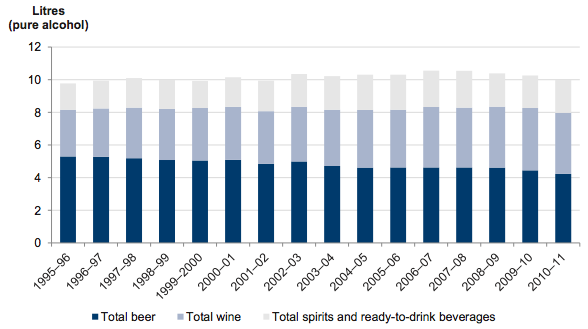
Note: Pure alcohol figures are based on the alcohol content of the beverage, rather than the total volume of liquid consumed.
Note: Per capita figures are calculated using population data for people aged 15 years and over.
Source: Victorian Auditor-General’s Office based on Australian Bureau of Statistics data.
In 2009, the National Health and Medical Research Council released the revised Australian Guidelines to Reduce Health Risks from Drinking Alcohol. These guidelines are based on the concept of a ‘standard drink’, where one standard drink contains 10 grams of pure alcohol.
Examples of approximately one standard drink are:
- 375 ml or one ‘stubbie’ of mid-strength beer (3.5 per cent alcohol content)
- 100 ml or one small glass of wine (11.5 per cent alcohol content)
- 30 ml of spirits (40 per cent alcohol content).
The National Health and Medical Research Council’s guidelines are the same for both men and women. They recommend drinking no more than:
- two standard drinks on any day—to reduce the risk of suffering long-term alcohol‑related harm
- four standard drinks on a single occasion—to reduce the risk of suffering short‑term alcohol-related harm.
According to the Australian Institute of Health and Welfare’s 2010 National Drug Strategy Household Survey, 20 per cent of Australians aged 14 and over consume more than two standard drinks per day on average, and 28 per cent drink more than four standard drinks on a single occasion at least once per month. The same survey indicates that 45 per cent of Victorians aged 14 years and older drink at least weekly.
1.2 Alcohol industry in Victoria
There are over 19 000 active liquor licences and BYO permits in Victoria. These are held by operators including pubs, bars, restaurants, clubs, bottle shops, wineries and event organisers. Approximately 78 per cent of the total volume of alcohol sold in Australia in 2009 was for off-premises consumption. Packaged liquor is primarily consumed in private homes.
The number of licences does not reflect the number of actual licensed premises because a single venue may have multiple licences for different purposes. The number of licences has remained relatively constant since 2009 as new licence applications have been processed and existing premises have combined multiple licences into one.
Figure 1B shows how the number of active licences has changed since 1995.
Figure 1B
Active licences in Victoria as at 30 June 1995–2011
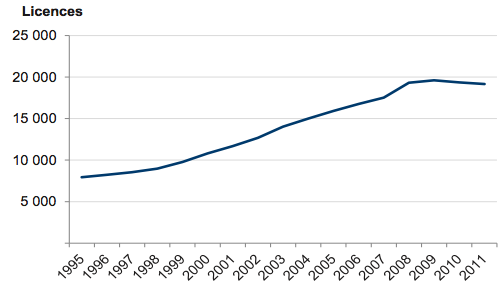
Source: Victorian Auditor-General’s Office.
1.3 Addressing alcohol-related problems
The short- and long-term harm caused by alcohol can have wide-ranging impacts on the economy and society. According to a report commissioned by the Department of Justice (DOJ), the social cost of short- and long-term alcohol-related harm in Victoria in 2007–08 was $4.3 billion. However, the actual total is likely to be even higher, as some costs, such as those due to child abuse and neglect, are particularly difficult to quantify. Figure 1C shows the breakdown of the total measured cost to Victoria.
Figure 1C
Cost of alcohol-related harm to Victoria
Type of cost |
Cost ($ million) |
Per cent of total |
|---|---|---|
Direct costs |
1 987 |
46.3 |
Road accidents |
571 |
13.3 |
Healthcare |
530 |
12.3 |
Crime |
448 |
10.4 |
Resources used in abusive consumption |
438 |
10.2 |
Indirect costs |
1 144 |
26.6 |
Workforce labour costs |
1 139 |
19.3 |
Household labour costs |
414 |
7.0 |
Other costs including education and research |
15 |
0.4 |
Resources saved |
–425 |
N/A |
Intangible costs |
1 165 |
27.1 |
Loss of life |
1 073 |
25.0 |
Pain and suffering |
92 |
2.1 |
Total |
4 296 |
100 |
Note: Differences are due to rounding.
Note: Where available, the figures include the costs of alcohol and illicit drugs used together.
Source: Victorian Auditor-General’s Office based on Collins, DJ & Lapsley, HM, The costs of tobacco, alcohol and illicit drug abuse to Australian society in 2004/05, 2008, and Allen Consulting Group, Alcohol-related harm and the operation of licensed premises, 2009.
Contained within these figures is the cost to the public sector. Approximately $366 million, or 9 per cent of the total cost, was borne by the government, primarily through the provision of policing and health services.
Strategies, legislation and regulation have been put in place to minimise the potential adverse effects of alcohol misuse.
1.3.1 Strategies
In 2002, the Department of Human Services (DHS) launched the Victorian Alcohol Strategy: Stage One. The strategy was described as ‘the first stage in the government’s approach to alcohol misuse and harm’.
In 2005, DOJ began work on developing and implementing a range of localised initiatives in the entertainment precincts of the four inner-city councils: Melbourne, Port Phillip, Stonnington and Yarra.
In 2008, DHS released Restoring the Balance: Victoria’s Alcohol Action Plan 2008–13 (VAAP). Responsibility for implementing VAAP rested primarily with DHS, the Department of Health (DOH), DOJ and Victoria Police. The justice component of VAAP focused on enforcing controls over licensed premises and the sale and marketing of alcohol, and preventing and reducing the effects of alcohol misuse, such as alcohol‑fuelled violence.
DOJ and Victoria Police had 14 actions to deliver under VAAP, which largely focused on the licensed hospitality industry and alcohol-related harm in public places:
- enhance enforcement of the Liquor Control Reform Act 1998
- review liquor licensing fees
- review obligations of managers and employees of licensed premises
- consider introducing under-age operatives
- review compliance with the voluntary water guidelines to provide free or low-cost drinking water on licensed premises
- develop an assault reduction strategy
- introduce late-hour entry restrictions
- freeze the issuing of late night liquor licences
- implement new security camera regulations
- review patron numbers in high-risk venues
- amend the Victoria Planning Provisions
- consider a new rehabilitation system for high-risk drink-driving offenders
- extend the zero blood alcohol concentration limit for young drivers
- conduct the Safe Streets public safety research and pilot evaluation.
While implementing its VAAP actions, DOJ worked concurrently on additional measures to combat alcohol-related harm. These included issuing guidelines on appropriate alcohol promotions and venue design to improve safety.
Following the 2010 election, VAAP was replaced by the initiatives contained in the Plan for Liquor Licensing.
In 2011, consultation on the new whole-of-government alcohol and drug strategy began. The strategy is due to be launched in 2012.
Figure 1D
Time line of whole-of-government alcohol strategies and initiatives
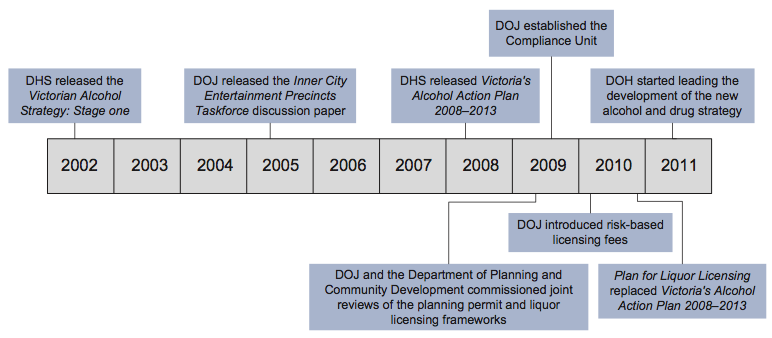
Source: Victorian Auditor-General’s Office.
1.3.2 Legislation and regulation
The Liquor Control Reform Act 1998 regulates the supply and consumption of liquor. The Act aims to minimise harm arising from the misuse and abuse of alcohol by:
- providing adequate controls over the supply and consumption of liquor
- ensuring that the supply of liquor contributes to, and does not detract from, the amenity of community life
- restricting the supply of certain alcoholic products
- encouraging a culture of responsible consumption of alcohol and reducing risky drinking of alcohol and its impact on the community.
The Act also aims to:
- facilitate the development of a diversity of licensed facilities reflecting community expectations
- contribute to the responsible development of the liquor, licensed hospitality and live music industries.
The supply of alcohol is primarily regulated through liquor licences. As at May 2012, the Act identifies 11 categories of liquor licences and permits:
- general licence
- on-premises licence
- restaurant and café licence
- club licence
- packaged liquor licence
- late night licence
- pre-retail licence
- wine and beer producer’s licence
- limited licence
- major event licence
- BYO permit.
The applicant’s business determines the type of licence required. Licences associated with greater risk of alcohol-related harm have higher fees and more stringent conditions.
Licensees’ obligations under the Act include:
- supplying liquor in accordance with their licence conditions
- completing Responsible Service of Alcohol (RSA) training
- publicly displaying their licence and other prescribed information
- not allowing their venue to adversely affect the amenity of the surrounding area
- fulfilling administration and record keeping requirements
- supplying free drinking water
- allowing the premises to be inspected when required.
Licensees who do not meet their obligations may have their licence cancelled or suspended.
1.4 Stakeholders
Many government agencies and other groups contribute towards meeting the objectives of the Liquor Control Reform Act 1998 and managing alcohol-related harm.
Department of Justice Alcohol Policy Unit
The Alcohol Policy Unit within DOJ is responsible for developing alcohol policy and guiding the implementation of justice initiatives. Until February 2012 the Alcohol Policy Unit was part of Responsible Alcohol Victoria. Responsible Alcohol Victoria was also responsible for liquor legislation and regulation, and monitoring licensees’ compliance.
Victorian Commission for Gambling and Liquor Regulation
The Victorian Commission for Gambling and Liquor Regulation (VCGLR) determines licence applications and enforces liquor and gambling laws. Created in February 2012, this new body combines the business services, training and compliance areas of Responsible Alcohol Victoria with the functions of the Director of Liquor Licensing and the Victorian Commission for Gambling Regulation.
The liquor enforcement function is undertaken by specialist compliance inspectors. The Compliance Unit’s main aim is to ‘ensure that alcohol is promoted and sold in a way that encourages responsible and appropriate drinking’. Inspectors work to achieve this by educating licensees about their obligations, monitoring licensees’ compliance with liquor legislation and licence conditions and making recommendations about:
- varying licence conditions
- taking disciplinary action
- prosecuting licensees and their staff.
The Compliance Unit was created to supplement Victoria Police’s operations in enforcing liquor laws.
Victoria Police
Victoria Police focuses on serious breaches of liquor legislation and public order offences relating to alcohol consumption. This is achieved by carrying out targeted and covert operations in addition to day-to-day policing. Victoria Police’s other responsibilities relating to liquor include commenting on the suitability of liquor licence applicants and participating in liquor licensing forums.
Local councils
Local councils grant or reject planning permits. They also have the power and opportunity to provide input into licensing applications, participate in liquor licensing forums, and implement local strategies to minimise alcohol-related harm, for example by introducing and enforcing by-laws. Some councils have local alcohol action plans to guide policy development and set targets for reducing alcohol-related harm in their area.
Other stakeholders
Many other government and non-government bodies play a role in the liquor and licensed hospitality industry and the prevention of alcohol-related harm. These bodies have a range of interests and backgrounds, including health, transport, tourism, small business, alcohol dependency services, industry peak bodies and research organisations.
The number and type of stakeholders mean that consultation on alcohol strategy development and implementation is necessarily complex and wide ranging.
1.5 Audit objective and scope
The audit objective was to assess the effectiveness of DOJ, Victoria Police and VCGLR’s initiatives and actions in:
- enforcing controls on the sale and marketing of alcohol
- preventing and reducing the impact of short-term alcohol-related harm on the community.
Four councils were consulted during the audit: City of Casey, City of Greater Geelong, City of Melbourne and Swan Hill Rural City Council.
1.6 Structure of the report
The rest of this report is structured as follows:
- Part 2 provides an overview of alcohol-related harm, and examines strategy development, implementation and evaluation
- Part 3 analyses the liquor licensing regime
- Part 4 assesses the enforcement activities undertaken by Victoria Police and VCGLR
- Appendix A presents data on alcohol consumption and harm.
1.7 Audit method and cost
The audit was performed in accordance with the Australian Auditing and Assurance Standards. The total cost of the audit was $410 000.
2 Strategy development, implementation and evaluation
At a glance
Background
The Victorian Alcohol Strategy: Stage One was launched in 2002. It was followed six years later by Restoring the Balance: Victoria's Alcohol Action Plan 2008–13 (VAAP). In 2011, work began on a new alcohol and drug strategy.
Conclusion
Alcohol-related harm has increased over the past decade. The Department of Justice's (DOJ) poorly developed, implemented and evaluated initiatives have not been effective in reversing the trend of increasing harm.
Findings
- DOJ's initiatives to prevent and reduce alcohol-related harm were fragmented, superficial and reactive instead of targeted, evidence-based, complementary and well coordinated.
- Stakeholder consultation was inadequate and numerous ad hoc initiatives were implemented outside the strategy. This resulted in unintended financial consequences for small businesses.
- Due to the lack of comprehensive, accurate and shared data, and the inadequate evaluation of VAAP, it is likely that the new alcohol and drug strategy will be similarly limited in achieving the intended outcomes.
Recommendations
The Department of Health should lead the development of:
- a coherent whole‑of‑government policy position on alcohol consumption and the liquor and hospitality industry
- a consolidated database to facilitate meaningful and accessible analysis of alcohol consumption and harm.
DOJ should pilot the collection and analysis of liquor sales data from wholesalers to retailers.
2.1 Introduction
The Department of Health (DOH) coordinates alcohol policy development across government. The Department of Justice (DOJ) leads the Justice portfolio's alcohol activities within the overarching government framework.
The whole-of-government strategy Restoring the Balance: Victoria's Alcohol Action Plan 2008–13 (VAAP) aimed to reduce:
- risky drinking and its impact on families and young people
- the consequences of risky drinking on health, productivity and public safety
- the impact of alcohol-fuelled violence and antisocial behaviour on public safety.
In 2010, work began on implementing the initiatives in the Plan for Liquor Licensing.
In 2011, DOH started leading the development of a new alcohol and drug strategy. The new strategy had not been finalised by the tabling date of this audit report.
This Part provides an overview of alcohol-related harm data, and assesses the development, implementation and evaluation of alcohol initiatives, with a particular focus on DOJ's activities.
2.2 Conclusion
The increase in reported short-term alcohol-related harm over the past 10 years indicates that strategies to mitigate alcohol-related harm have not been successful. More people require medical attention for intoxication, and the number of assaults and injuries has increased. The extent of the problems caused by alcohol is, however, understated because of shortcomings in data collection, analysis and dissemination.
Multiple agencies are involved in alcohol policy, many with competing interests. There is no whole-of-government policy position on alcohol and the liquor and hospitality industry to resolve these competing interests. The consequence of these unresolved issues in 2008 was a diluted strategy with limited effectiveness.
DOJ has made efforts to minimise the harmful effects that can arise from alcohol consumption. However, the effectiveness of its efforts has been reduced by poorly chosen and implemented strategies. The DOJ component of VAAP was a fragmented series of reactive, often small-scale initiatives that were action-based, rather than outcome‑based. They did not make a purposeful, direct and collective contribution towards minimising harm, and were not sufficiently underpinned by evidence.
VAAP was launched six years after it was first proposed. Despite this length of time, poor planning meant DOJ's initiatives had unforeseen and unintended consequences—stakeholder consultation was inadequate and numerous ad hoc initiatives were implemented outside the strategy.
DOJ's ability to develop evidence-based strategies has been further limited by the inadequate evaluation of previous initiatives. DOJ has spent approximately $67 million since 2007–08 on developing and implementing alcohol policy, liquor licence regulation and compliance inspections, yet its evaluation of what it has achieved from this significant investment has been limited.
The lack of a centralised database of harm data also impedes evidence-based strategy development. The relationship between alcohol and harm is obscured by incomplete and inconsistent recording of the presence of alcohol in police and medical data. These gaps and inaccuracies diminish the quality of any analysis on alcohol's contribution to harm. In this regard, Victoria has fallen behind other jurisdictions.
The lack of comprehensive, accurate and shared data and inadequate evaluation of VAAP means it is likely that the new strategy will be similarly limited in achieving its intended outcomes.
2.3 Alcohol consumption and harm
Alcohol-related harm has increased significantly over the past 10 years. Although there are issues regarding the comprehensiveness and accuracy of data, there are strong patterns of increased harm across almost all indicators from a variety of sources. This provides a compelling case that harm is indeed widespread and increasing. These types of indicators are included in the draft alcohol and drug strategy as the best data currently available.
The increase indicates that harm reduction actions have had limited effectiveness.
2.3.1 Alcohol consumption and intoxication
Surveys have consistently revealed that over 80 per cent of the adult population drink. Approximately 75 per cent of Australians believe more needs to be done to reduce alcohol-related harm, but only 6 per cent are concerned about their own drinking.
Figure 2A shows there are some similarities in medical data on alcohol intoxication and patterns of per capita consumption. This figure is based on population rates, and therefore adjusts for the impact that the rising number of residents has on the number of incidents.
Figure 2A
Ambulance, emergency department and hospitalisation rates for intoxication versus alcohol consumed
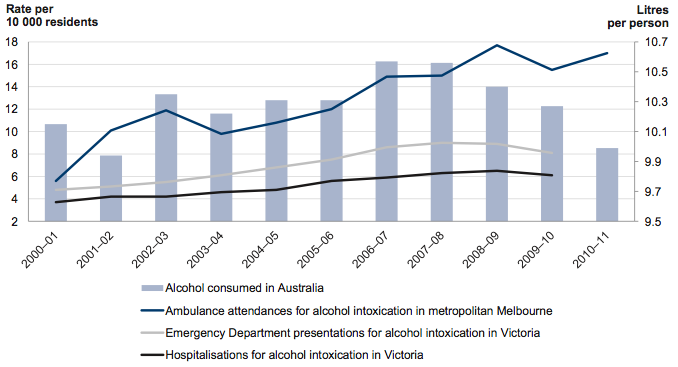
Note: Data for alcohol consumption and ambulance attendances is not available for Victoria.
Note: 2010–11 data was not available for Emergency Department presentations or hospitalisations at the tabling date of this report.
Source: Victorian Auditor-General's Office based on Turning Point and Australian Bureau of Statistics data.
While the above figure is based on rates per 10 000 residents, the total number of Victorians recorded as needing medical assistance as a result of alcohol intoxication has increased dramatically. According to Turning Point data:
- there were 6 946 ambulance attendances for alcohol intoxication in metropolitan Melbourne in 2010–11, which is more than 3.5 times higher than in 2000–01
- there were 4 425 emergency department presentations for intoxication in Victoria in 2009–10, which is an increase of 93 per cent since 2000–01
- there were 3 343 people hospitalised for alcohol intoxication in Victoria in 2009–10, which is an increase of 87 per cent since 2000–01.
Besides government interventions, other factors, such as broader economic conditions, have a strong influence on alcohol consumption rates. For example, studies in both Europe and America have shown that the consumption of alcohol tends to increase during times of economic prosperity, and decrease during economic downturns.
2.3.2 Alcohol-related injuries and assaults
As Figure 2B shows, the recorded rates of hospital admissions for alcohol-related injuries have increased by 32 per cent over the past 10 years.
However, rates of hospitalisation for alcohol-related road trauma have remained relatively stable during the period. The comparative stability of these rates may be due to a range of other factors, including improved vehicle safety, drink-driving interventions and other measures, such as more road safety cameras.
Figure 2B
Alcohol-related hospitalisations in Victoria
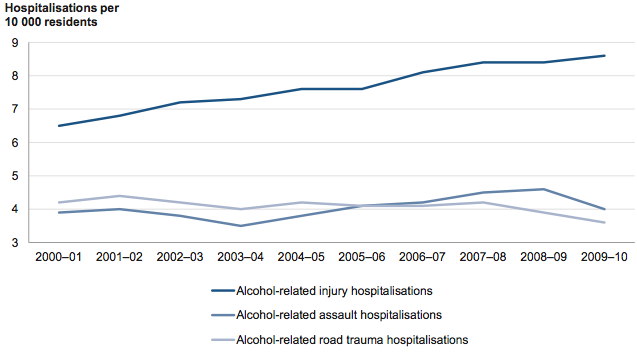
Note: Alcohol-related hospitalisations are estimated using a formula based on analysis of past cases to calculate the likelihood of alcohol causing the patient's medical condition.
Source: Victorian Auditor-General's Office based on Turning Point data.
Victoria Police data indicates that the number of victims reporting alcohol-related family violence has more than doubled since 2000–01. This has been an area of focus for Victoria Police in recent years, and increased enforcement effort typically results in increased reporting. Neither DOJ nor Victoria Police can determine how much of the increase is due to a change in the approach to policing family violence and how much is due to the number of actual offences increasing. Figure 2C shows the number of victims per 10 000 residents reporting family violence.
Figure 2C
Alcohol-related family violence in Victoria
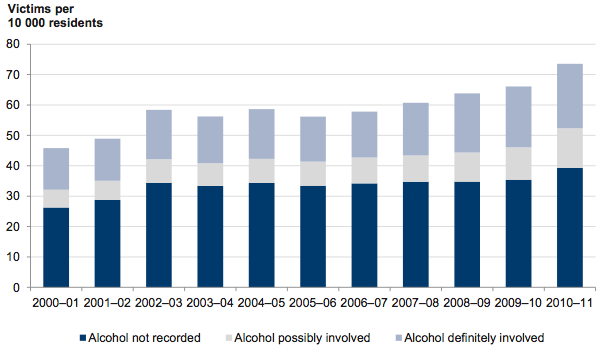
Source: Victorian Auditor-General's Office based on Victoria Police data.
Rates of alcohol-related harm are increasing faster for women and young people than for other demographic groups. These trends are apparent across both health and police data.
Further analysis of consumption and harm data is in Appendix A.
2.4 Strategy development
Alcohol policy is highly contentious. Community attitudes to alcohol are complex and often ambiguous. Although alcohol is deeply embedded in the Australian culture, there is also widespread concern about the severe consequences that can result from excessive consumption.
Effective strategy development depends on a clear policy position, timely responses and a robust evidence base. Specific, targeted strategies may be required for particular groups in order to be effective.
2.4.1 Strategy coherence
A whole-of-government position on alcohol would set a clear direction for the new alcohol and drug strategy, and minimise the likelihood of repeating the same issues experienced with VAAP. No statement of policy had been endorsed by the tabling date of this audit report.
Stakeholders in alcohol policy are many and varied. They therefore have a range of differing perspectives on alcohol consumption and the industry:
- health—health services providers, such as hospitals and drug treatment centres, advocate tighter controls over the sale of alcohol in order to reduce the medical burden of injuries and disease that can result from alcohol consumption
- business—hospitality and tourism organisations aim to promote a thriving 'night‑time economy', which generally involves alcohol consumption
- community—councils and local interest groups seek to encourage local investment while preventing and reducing alcohol-related public disorder and health issues in their municipality
- justice—DOJ, the Victorian Commission for Gambling and Liquor Regulation (VCGLR) and Victoria Police aim to minimise harm by encouraging licensees and the public to serve and consume alcohol responsibly, and by carrying out enforcement action for more serious or ongoing offences.
In the absence of a statement of policy to guide how these competing interests should be resolved, the justice component of VAAP was little more than a series of superficial, standalone actions whose connection with the strategy's objectives was not explicit. For instance, although one of DOJ's stated intentions was to have 'properly enforced controls on the sale and marketing of alcohol', none of DOJ's actions related directly to product marketing.
This disconnect between the desired outcomes of the strategy and its actions has resulted in other ad hoc actions being developed separately in an attempt to achieve these outcomes. For instance, significant progress was made outside the VAAP framework in discouraging marketing and promotions that encouraged risky drinking. This might have been avoided had the strategy been based on more robust evidence and a stronger, more logical structure.
There has been ample time to prevent these issues arising. The whole-of-government Victorian Alcohol Strategy: Stage One was launched in 2002 as 'the first stage in the government's approach to alcohol misuse and harm'. The launch of VAAP was deferred until 2008, to allow time for further reviews and Parliamentary inquiries to be carried out.
Over the six-year period that VAAP was being developed, the number of licences in Victoria increased by 52 per cent. Hospitalisations for alcohol‑related assault increased by 22 per cent. The rate of ambulance attendances for intoxication and reported alcohol-related family violence also increased during this period.
At the tabling date of this report, the new alcohol and drug strategy had been under development for over a year. The strategy was initially due for release before the end of 2011, but is now expected to be launched later in 2012.
2.4.2 Evidence base
The availability and reliability of data underpins evidence-based strategy development and evaluation. Insufficient action has been taken to address the omissions and inaccuracies in the data and incorporate better practice.
Better practice
Harm minimisation has been the primary objective of the Liquor Control Reform Act 1998 since 2009. However, DOJ's strategies have not reflected better practice harm minimisation methods. Research has repeatedly shown that increasing the price of alcohol reduces demand and restricting its availability reduces supply. These measures have the effect of decreasing the level of overall consumption, which, in turn, reduces alcohol-related harm. DOJ advised that it does not dispute these research findings.
However, given a large proportion of the population drinks alcohol, increasing its price and reducing its availability by limiting the number of outlets and trading hours can be unpopular with the liquor and licensed hospitality industries, tourist organisations and the affected sections of the community.
Victoria cannot directly control the price of alcohol, as liquor licence fees based on sales volume are deemed an excise, which is a federal government power. Since the state cannot use pricing as a harm minimisation strategy, it is reasonable to expect DOJ to compensate for this by providing advice on ways to significantly enhance controls over supply instead. It has not done so.
Only one of the 14 justice actions in VAAP creates specific additional controls over availability and therefore supply—the freeze on issuing new late-night liquor licences. This measure was limited in scope, as it was only applicable to new licence applications in four local government areas.
VAAP was a missed opportunity to implement a range of actions that were proven to be effective at preventing and reducing alcohol-related harm by controlling supply.
Data on alcohol use
Many of DOJ's activities directly or indirectly target reducing consumption rates, yet it does not collect alcohol sales data. This data would allow DOJ to reliably measure the impact of its activities on overall consumption rates and comprehensively analyse the relationship between consumption patterns and alcohol-related harm.
DOJ stopped collecting sales data ostensibly because of a 1997 ruling by the High Court of Australia that liquor licensing fees levied by state governments based on sales data were duties of excise, and therefore not valid under the Australian Constitution. However, Western Australia, Queensland and the Northern Territory, with the same limitation of powers, continue to collect and analyse sales data.
The Drug and Crime Prevention Committee of Parliament, the Department of Premier and Cabinet (DPC), Department of Treasury and Finance (DTF) DOH and DOJ have at various times all expressed their support for the collection of sales data. In particular, DTF emphasised that the current lack of data was inhibiting agencies’ ability to undertake Business Impact Assessments and Regulatory Impact Statements.
DOH commissioned a review in 2010 to assess the options and feasibility of collecting sales data. The review concluded that data on sales from wholesalers to retailers would provide the most reasonable balance between cost and accuracy, rather than collecting either a sample of, or full retail sales data. The review estimated that the cost to government over 10 years of collecting sales data from wholesalers would be $153 714, excluding IT system set-up and maintenance, communications, enforcement and data analysis. The cost to industry was estimated at $9.9 million, or $506 per licensee, over 10 years.
The collection of wholesale data was not pursued on the basis of these costs and the regulatory burden this was perceived to impose on industry. However, these costs are trivial compared with the estimated $4.3 billion that alcohol-related harm costs Victoria each year.
Other options that would improve data on the amount of liquor sold by licensees include requiring them to provide details of their turnover or the size of their premises as part of the annual licence renewal process. Changes to legislation may be required to enable VCGLR to obtain this information.
Data on alcohol-related harm
The lack of a centralised database of harm data limits:
- DOJ's capacity to develop evidence-based strategies
- the quality of decisions made on liquor licence applications
- the ability of Victoria Police and VCGLR to carry out intelligence-led enforcement.
The relationship between alcohol and harm is further obscured by incomplete and inconsistent recording of the presence of alcohol in police and medical data. Health data is slightly more robust than police data, as it is scrutinised more closely by research bodies.
Nonetheless, these gaps and inaccuracies diminish the quality of the analysis of alcohol's contribution to harm. Victoria has fallen behind other jurisdictions, where offenders and patients are asked about their alcohol consumption in a more structured and methodical manner.
Agencies have their own intelligence gathering procedures and methods, and develop enforcement strategies accordingly. Communication and information sharing between enforcement agencies, particularly in outer Melbourne and regional and rural Victoria, is largely ad hoc and on a 'need-to-know' basis. There is therefore duplication of effort without robust information sharing systems and strategies.
Multiple agencies including Victoria Police, VCGLR and local councils are involved in monitoring and responding to issues with licensed venues and to alcohol-related harm. Victoria Police and VCGLR separately record data on offences and infringements, VCGLR records breaches of liquor licence conditions and councils record breaches of the planning permit. Complaints from the public may be received by the police, VCGLR or councils.
This is a missed opportunity to build a whole-of-government 'early warning system' that identifies potential alcohol-related harm and problem venues before matters escalate. A central intelligence database to collate, analyse and share data from both crime and health sources would assist a coordinated effort by agencies to develop intelligence‑led strategies to deal with identified problems. Protocols on the sharing of information would appropriately reflect the sensitivity of the information.
Enforcement is covered in more detail in Part 4.
2.4.3 Strategy for vulnerable groups
Alcohol-related harm is increasing faster for young people than other age groups. Agencies' attempts to balance the health risks of alcohol consumption with public opinion and freedom have created inconsistencies between policy and within the legislation itself with regard to young people's consumption of alcohol. This sends mixed messages to the community and reduces the effectiveness of efforts to minimise harm.
Alcohol abuse in young people is linked to a range of harms including mental illness, sexual risk-taking and injuries. Early onset of alcohol abuse increases the risk of developing alcohol or other drug dependencies in later life. Because of the health risks associated with under-age alcohol consumption, health agencies recommend delaying the age at which alcohol is first consumed.
However, despite the health risks, the law permits under-18s to consume alcohol in certain supervised circumstances. According to a 2008 survey of Victorian secondary school students, by the age of 16:
- 92 per cent of respondents had consumed alcohol in their lifetime
- 40 per cent had consumed alcohol within the past week.
The Packaged Liquor Code of Conduct on VCGLR’s website does not, however, allow a packaged liquor outlet employee to sell alcohol if it appears that an adult is purchasing liquor for a minor, even if the adult in question is legally able to supply alcohol to that minor because they are either the child's parent or have the appropriate parental consent.
Under-age drinking has appeared in the Victorian Alcohol Strategy: Stage One and VAAP and the draft new alcohol and drug strategy. This repetition demonstrates agencies' lack of progress in addressing this problem area over the past 10 years. Statistics show that:
- there has been a 62 per cent increase between 2002 and 2009 in the number of 16–24 year olds who reported consuming 20 standard drinks or more in one day on at least one occasion within the past year
- the number of young people attending emergency departments for intoxication nearly tripled between 2000–01 and 2009–10.
2.5 Strategy implementation
Strategies that are poorly developed and/or implemented may have unintended consequences, such as heavy and often unnecessary financial costs being imposed on businesses and agencies.
2.5.1 Unintended consequences
DOJ’s alcohol actions were adversely affected not only by shortcomings in strategy development, but also in the implementation phase.
Figure 2D describes the unintended consequences from the late-night entry restrictions—‘the lockout’. The lockout was introduced to minimise the number of people moving between late-night venues in an attempt to reduce violence and antisocial behaviour.
Figure 2D
Case study—the lockout
In April 2008—two months before the lockout was launched—DPC noted: ‘There has been no industry consultation on the lockout proposal. There are a number of risks associated with this proposal, including unintended impacts, impacts on business and tourism and increased patronage for gaming venues’.
In May 2008 the Director of Liquor Licensing announced a temporary lockout covering the Melbourne, Port Phillip, Stonnington and Yarra local government areas.
In June 2008 the lockout began. The lockout lasted for three months, during which time licensees were banned from allowing patrons to enter or re‑enter their premises after 2 am. The lockout was not extended after the initial period ended in September 2008.
The lack of buy-in from the late-night licensed hospitality industry and their patrons fundamentally compromised the lockout. A total of 120, or approximately 25 per cent of affected venues, successfully applied for an exemption from the Victorian Civil and Administrative Tribunal (VCAT). There were public protests against the lockout.
According to focus groups conducted by the consultant engaged by DOJ to evaluate the lockout, smaller venues were most adversely affected by the entry restrictions, as patrons left them earlier than usual to get into late night venues prior to the 2 am lockout. This adverse unintended impact was not highlighted as a potential risk prior to implementation.
As a consequence of the large number of exemptions:
- enforcing the lockout was difficult
- patrons who were refused entry to one venue simply went to another that was exempt from the lockout
- the reduction in public order and drunkenness was much less than in the lockout implemented in the Gold Coast.
Further, although the number of reported assaults decreased between 8 pm and 12 am, they increased between 12 am and 4 am. The report suggests this was due in part to a lack of available late night transport options to move people away from Melbourne’s Central Business District.
Other, more successful, lockouts have been combined with actions such as graduated closing times and improved public transport. The temporary lockout may have been more successful if there had been better, more collaborative planning and more comprehensive consultation with stakeholders and the VAAP advisory group.
Source: Victorian Auditor-General's Office.
2.5.2 Stakeholder engagement
DPC and DTF repeatedly raised concerns about the lack of effective consultation with stakeholders, following criticisms from the liquor and licensed hospitality industry on the poor quality of consultation.
DOJ advised that the short time lines set between announcing and delivering VAAP, and subsequent ad hoc initiatives, required DOJ to focus on implementing actions, rather than gathering evidence, consulting with stakeholders, and evaluating performance. A VAAP stakeholder engagement strategy was only endorsed in October 2008, five months after VAAP was launched.
2.5.3 Ad hoc actions
Over 50 actions have been undertaken by DOJ concurrently with, but outside, a strategic framework since 2008.
The measures introduced have included alcohol and violence media campaigns, design guidelines for licensed premises and amendments to legislation on disparate and topical matters such as party buses and ANZAC Day trading hours. There have been individual successes, such as the risk-based fee structure, which achieved a reduction in harm by encouraging venues to reduce patron numbers and trading hours.
However, the actions were fragmented in terms of both their design and implementation. This lack of cohesion limited the overall effectiveness and efficiency of DOJ's efforts.
It is to be expected that unforeseen issues will arise and require a rapid response. However, because the initiatives implemented were not part of a strategy, they were not subjected to a robust assessment or cost/benefit analysis to determine whether they were not only feasible but also the most effective and efficient use of resources.
As a result, actions were publicly announced but subsequently abandoned or postponed. For example, differentiated fees for different types of packaged liquor outlets were not implemented as they equate to an excise and are therefore unconstitutional. Another example was the review of restrictions on point-of-sale materials, which is described in Figure 2E.
Figure 2E
Liquor Control Advisory Council review of point-of-sale materials
The Liquor Control Advisory Council was established to advise the Minister for Consumer Affairs on problems of alcohol abuse and on any other matters referred to it by the minister. The council's members are drawn from the liquor industry and health service providers.
One of the matters the council was asked to advise on was the impact of point-of-sale promotions on alcohol consumption.
In an out-of-session meeting in September 2010, the council noted that ‘the gap in conclusive [point-of-sale] evidence suggests that no decisive action can be taken at this stage’ and recommended that further research be carried out.
Of the nine people who attended this meeting, four worked in the liquor industry. For these members, the point-of-sale assignment was a clear conflict of interest, as they were being asked to make recommendations on a matter that had the potential to reduce sales and therefore detrimentally affect their business.
This unsatisfactory stalemate might have been avoided had sales data been collected in Victoria. This information could have been used to map the correlation between promotions and sale patterns, rather than postponing a decision for two years while further research is conducted.
Source: Victorian Auditor-General's Office.
2.6 Performance evaluation
The performance evaluation framework for VAAP was not robust and there was no holistic evaluation of the actions' impact. This is despite the statement in VAAP that 'the government will monitor progress against these outcome measures of the five-year period of the plan to 2013'.
The framework was ambiguous and not comprehensive, which meant that data and data sources could be used selectively for the evaluation:
- Only two of VAAP's three aims were included—'reduce the impact of alcohol‑fuelled violence and antisocial behaviour on public safety' was omitted, despite this being a key community concern.
- It was unclear how the outcomes would be measured, as the list of data sources was not comprehensive and it was not obvious which specific actions the data sources would be used to assess.
- Although VAAP was launched in May 2008, DOH did not commission work to define a more detailed set of measurement bases and data sources until March 2009.
- Performance targets were not quantified and there was no baseline data against which improvements would be measured in VAAP.
Inappropriately assessing options and evaluating performance can lead to decisions that are not soundly based. Not disclosing targets and detailed measurement bases allows improvements to be claimed even when they are marginal and below expectations.
DOJ commissioned reviews of some of its initiatives, including the lockout and the newly created Compliance Unit, which is discussed in more detail in Part 4. It also performed an internal review of the changes to the liquor licence fees. However:
- the usefulness of the department's reviews was limited due to factors including a lack of complete and accurate baseline data
- DOJ did not measure the effectiveness of other initiatives. For instance, the 12‑month ban on issuing new late-night liquor licences in the local government areas of Melbourne, Stonnington, Yarra and Port Phillip—'the freeze'—was not evaluated before it was extended.
DOJ believes that it would have acted inappropriately if it had allocated resources to carry out an evaluation after VAAP was replaced in November 2010.
The inadequate evaluation of VAAP means there is a risk that the new alcohol and drug strategy that is currently being developed will be similarly limited in achieving the intended outcomes.
The shortcomings in DOJ's strategy development, implementation and evaluation were compounded by deficiencies in liquor legislation and regulation. These issues are discussed in Part 3.
Recommendations
-
The Department of Health should, as the coordinating department
for the new alcohol and drug strategy, lead the development of:
- a coherent whole‑of‑government policy position on alcohol consumption and the liquor and hospitality industry
- clear lines of accountability for alcohol policy implementation
- a consolidated database to facilitate meaningful and accessible analysis of alcohol consumption and harm.
-
The Department of Health should:
- identify and apply the lessons learned from the development and implementation of Restoring the Balance: Victoria's Alcohol Action Plan 2008–13 to inform future strategy development
- improve the quality of data it collects on alcohol consumption and harm.
-
The Department of Justice should:
- pilot the collection and analysis of liquor sales data from wholesalers to retailers
- improve communication with stakeholders in the development and implementation of initiatives.
3 Liquor licensing regime
At a glance
Background
There are particular planning requirements for land used to sell or store liquor. Packaged liquor outlets, hotels, clubs and restaurants selling liquor are required to have both a planning permit from the local council and a liquor licence.
Conclusion
Weaknesses and inconsistencies in the legislation and licensing processes have reduced agencies’ ability to effectively minimise alcohol-related harm.
Findings
- Poor administration has resulted in licensing decisions that are not in line with the harm minimisation objective of the Liquor Control Reform Act 1998 and that do not reflect community interests.
- Inconsistencies, a lack of clarity and excessive restrictions in the legislation reduce the effectiveness of harm minimisation strategies.
- Liquor licensing processes are complex and opaque.
Recommendations
The Department of Justice should, together with the Department of Planning and Community Development, overhaul the planning permit and liquor licence application processes to better address community and health concerns.
The Department of Planning and Community Development should:
- create a model local planning policy for licensed premises
- require councils to adopt a local planning policy for licensed premises where there is a particular need or concern.
The Victorian Commission for Gambling and Liquor Regulation should:
- review its licensing administration practices
- exercise closer oversight over training providers.
3.1 Introduction
The harm minimisation objective of the Liquor Control Reform Act 1998 is intended to be met by measures that include ‘providing adequate controls over the supply and consumption of liquor’. The planning permit and liquor licence application processes are important mechanisms to control the licensed environment.
The Department of Planning and Community Development (DPCD) administers the planning system, which provides the framework for regulating and managing how land is developed and used. Each of the 79 local government areas has a planning scheme, which combines both statewide and local policies and provisions. Councils use the planning scheme to decide whether to grant or refuse planning permits. Planning permits are required for most types of licensed premises.
Until February 2012, the Director of Liquor Licensing granted or refused liquor licences, based on the suitability of the applicant and the potential impact of the licensed premises on the amenity of the surrounding area. This function transferred to the Victorian Commission for Gambling and Liquor Regulation (VCGLR) in February 2012.
Liquor licences are a mechanism used to regulate:
- who supplies liquor
- to whom it is supplied
- when it is supplied/consumed
- where it is supplied/consumed
- how it is supplied.
Part of VCGLR’s stated role is to inform and educate industry and the general public about regulatory practices and requirements. A licence application may be refused if the applicant cannot demonstrate sufficient understanding of their obligations under the Act. Mandatory industry training is provided to help licensees and their staff gain this knowledge.
This Part assesses the extent to which agencies are meeting the harm minimisation objective of the Act, the effectiveness and efficiency of the liquor licensing application process, including its interface with planning, and the appropriateness of the industry training overseen by VCGLR.
3.2 Conclusion
The liquor licensing and planning permit application processes do not sufficiently reflect community concerns. There are many instances where licences have been granted inappropriately—albeit not illegally—due to inconsistencies and weaknesses in the licensing regime. It is not possible to reliably quantify the extent of the issue due to the antiquated IT systems and the inaccurate, incomplete records VCGLR has inherited from the Department of Justice (DOJ).
The Act has been amended with the aim of achieving better community consultation on liquor licence applications. However, the intent of these changes is not being achieved due to a lack of effective engagement between VCGLR and councils.
Changes have also been made to the planning permit and liquor licence application system to improve the efficiency for stakeholders. Although the system is still not without flaws, councils could nevertheless engage more effectively. VCGLR could help councils in this regard by producing more comprehensive and timely guidance.
DOJ has recently reviewed and improved the industry training. However, inconsistencies in the delivery of the training, and poor quality data, indicate there is a need for closer oversight of training providers and the administration of the accreditation process.
Since the functions of the Victorian Commission for Gambling Regulation and Director of Liquor Licensing were recently integrated into one regulator, it is an opportune time to review their processes for consistency of application where appropriate.
3.3 Evolution of the licensed hospitality industry
There have been many significant changes in liquor legislation. These have been informed by various reviews of the industry, and have reflected changes in community attitudes and government policy regarding alcohol and the licensed hospitality industry.
3.3.1 Outcome of reviews
Successive changes to legislation in the 1980s and 1990s promoted competition and economic development. As these changes took effect, it became easier to obtain a liquor licence, and the number of licensed premises increased as a result. There has been some tightening of controls since 2008.
In 1986, the Nieuwenhuysen report Review of the Liquor Control Act 1968 was released. This review of the policy and legislative environment focused on the potential economic benefits that could be achieved by encouraging growth in the licensed hospitality industry. The review resulted in significant changes to liquor legislation and led to the development of Melbourne’s laneway culture.
However, there was also an unforeseen increase in large nightclubs and bars. These types of premises are associated with increased risk of alcohol-related harm because their late-night trading hours enable people to drink for an extended period.
Prior to 2002, no person or corporation was permitted to own more than 8 per cent of the general or packaged liquor licences. This restriction was deemed to breach the National Competition Policy and was consequently phased out. The number of packaged liquor licences increased 41 per cent between 2002 and 2011.
There have been several changes to the liquor licensing regime since Restoring the Balance: Victoria’s Alcohol Action Plan 2008–13 was launched in 2008, including:
- the harm minimisation objective of the Act has been strengthened by an amendment that broadened the definition of harm
- packaged liquor outlets are no longer exempt from the requirement to obtain a planning permit
- licence categories were amended to better reflect business needs
- a risk-based fee structure was introduced to require licensees associated with the most harm to pay comparatively higher licensing fees.
3.3.2 Research findings and industry data
A concentration of licensed premises in a particular area may provide economic and social benefits, such as creating a vibrant night-time activity centre that has a range of businesses and good transport links.
However, there is also evidence that increased outlet density is one factor that can result in a greater incidence of assaults, antisocial behaviour and drink driving. For example, research by Turning Point indicates there is a link between the density of packaged liquor outlets and rates of family violence, and that ‘policies that restrict the growth of the alcohol industry are likely to restrict increases in alcohol-related harm’.
The total number of licences in Victoria has remained relatively constant since 2009. However, the number of licences does not reflect the number of actual licensed premises, because a single venue may have multiple licences for different purposes.
Further, while one licensed premises may have held four or five licences for different activities in the past, VCGLR has worked with licensees to reflect a range of conditions that were previously covered by multiple licences—particularly temporary licences—on a single licence.
VCGLR is unable to measure the year-on-year movement in licensed premises due to poor quality address data.
Figure 3A shows the increase in the number of different types of liquor licence in Victoria since 2000.
Figure 3A
Liquor licences as at 30 June 2000–11
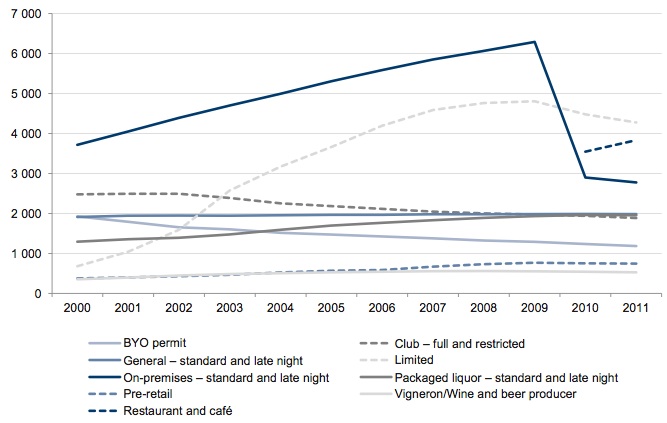
Source: Victorian Auditor-General’s Office based on Victorian Commission for Gambling and Liquor Regulation data.
Alcohol-related harm has increased faster than the number of licences. While the total number of licences increased by 77 per cent between 30 June 2000 and 2011:
- ambulance attendances for intoxication in metropolitan Melbourne increased by 258 per cent between 2000–01 and 2010–11
- the reported number of victims of alcohol-related family violence more than doubled between 2000–01 and 2010–11.
It should also be noted that not all premises are considered to have the same risk of alcohol-related harm. For instance, restaurants and cafés present a lower risk of alcohol-related harm than late-night venues. In 2011, 1 246 new licences and BYO permits were granted. Of these, 62 per cent were for restaurant and café and limited licence types.
Further analysis of harm and the underlying causes is in Appendix A.
3.4 Planning and liquor licensing framework
The harm minimisation objective of the Act is intended to be met by measures including ‘ensuring as far as practicable that the supply of liquor contributes to, and does not detract from, the amenity of community life’.
Accordingly, most types of outlets that sell liquor are required to have both a planning permit from the local council and a liquor licence from VCGLR. The impact on amenity is considered at both the planning permit application and the liquor licence application stages. Applications may be rejected if they are deemed to have a negative impact on the amenity of an area.
3.4.1 Consultation, objections and advice
There have been amendments to the Liquor Control Reform Act 1998 to achieve better community consultation on new and amended liquor licences. However, the intent of this change is not being achieved due to a lack of:
- evidence to support objections
- timely, clear guidance from VCGLR
- engagement from councils.
The legislation and licensing processes restrict the grounds on which councils can object to a liquor licence. Councils may object on the basis that granting the application would be detrimental to the amenity of the area, and—for packaged liquor outlet applications—would contribute to the misuse and abuse of alcohol.
The Victorian Civil and Administrative Tribunal (VCAT) has in the past rejected objections because no direct cause‑and‑effect relationship was established between the outlet in question and the alcohol-related harm that would ensue if the application was granted.
In a 2011 case, the Supreme Court found that VCAT had misconstrued the Act because it had only considered whether the decision to end late-night trading at a packaged liquor outlet would have definitely reduced alcohol-related harm, but not whether the decision would have contributed towards a reduction in harm.
This relationship can be difficult to assess, particularly for those sites where liquor has not been sold previously, or in growth areas. It is also especially challenging for packaged liquor outlets, as family violence is less visible than assaults in public areas. A centralised harm database would help agencies comprehensively assess applications.
The recent integration of the liquor and gambling regulators provides an opportunity to review processes to enhance efficiency and consistency. For example, the Gambling Regulation Act 2003 places the burden of proof on gaming venue operator licence applicants to demonstrate that their business will not result in a net detrimental economic and social impact on the wellbeing of the community. Gaming venue operator applicants are also required to provide significantly more detailed information to support their application than liquor licence applicants.
VCGLR has rejected objections from councils because they were invalid. The number of objections received and the outcome is unclear, as VCGLR does not maintain a record of this information. This omission means VCGLR is not identifying common trends in objections and gaps in stakeholders’ understanding. VCGLR should use this information to improve councils’ contribution to the licensing process.
It is part of VCGLR’s role to educate and inform people about regulatory mechanisms. Another way VCGLR should help councils participate more meaningfully in the licensing process is by improving its communication with councils. It could achieve this by:
- issuing clearer and more comprehensive guidelines for councils on lodging objections to liquor licence applications
- amending its advice to councils on how long they have to respond to applications so it is consistent with the Act
- providing feedback on VCGLR’s consideration of objections or any conditions councils have requested on a licence
- alerting councils when a liquor licence has been granted.
It is important for councils to engage in the planning permit and liquor licence application processes, as the process to subsequently address undesirable licence conditions, such as the mix and trading hours of licensed premises, is complex and onerous. Although there are flaws in the current system, councils should make better use of the opportunities available.
A review of files revealed that only nine of the 79 councils had lodged an objection that had proceeded to a panel hearing for a decision in 2010–11. One reason for the relatively low number of objections may be that the community is in favour of bringing more licensed premises into the area. However, the four councils visited during the course of the audit also advised that another key driver is the cost of pursuing objections, which councils are not specifically funded to do.
Councils could improve the quality of their decision-making and reduce the amenity impact by:
- involving social planners—who are likely to have a better understanding of the amenity impact of alcohol than statutory planners—in the planning permit application decision
- inserting conditions on planning permits and enforcing those conditions
- developing a local policy specifically for licensed premises to guide decision‑making on both planning permits for licensed premises, and referrals for liquor licences from VCGLR.
Currently, community interests are not being adequately represented or considered in liquor licensing decisions. This is due not only to a lack of guidance and engagement, but also administrative errors.
3.5 Administrative errors and inconsistencies
The Act requires VCGLR to consider potential harm, community expectations and industry interests when determining liquor licence applications. In most cases, VCGLR will consult with Victoria Police on the suitability of the applicant and the local council on the suitability of the location. Members of the community may also provide submissions on applications.
3.5.1 Licence application referrals
The Act does not require VCGLR to refer all types of licence applications to councils and the police, such as applications for limited licences and major event licences.
While the discretionary referral arrangements for limited and major event licences are intended to improve efficiency, there are instances of licences being issued inappropriately due to inadequate consultation with police and councils, and poor information management.
A new licence category for major events was created in 2010, which improved the transparency of these types of applications. However, police and councils may have little or no advance notice that a smaller scale event is occurring because:
- the VCGLR may not refer the liquor licence to the police and council
- a planning permit may not be required, even if the event is on public land
- one-off event or limited licence applications are often submitted shortly before the event.
Insufficient advance notice reduces the ability of police and councils to plan for events, in terms of public safety, traffic management and sanitation.
In one instance in 2012, the City of Casey Council was given three business days to respond to an application for a limited licence for a one-off event. The event took place without comment from the council, as it was given inadequate time and information to allow meaningful consultation to occur.
In another example, liquor licences were granted to the lessees of venues owned by the City of Greater Geelong Council, even though the lease did not permit alcohol to be served at the venue. The council became aware of the licences only after they were granted, as VCGLR did not refer them to the council.
Further, licences have been granted without due consideration of community input because VCGLR has misplaced documentation from councils—including objections.
3.5.2 Discrepancies between planning permits and liquor licences
There are discrepancies between planning permit and liquor licence conditions on details such as trading hours and patron numbers. Although these discrepancies can be minor, a licensee may inadvertently break the law if they do not understand that they are bound by the shortest trading hours and lowest patron numbers. This situation tends to be more of an issue for older licences.
For instance, the planning permit issued to a BYO restaurant in Swan Hill in 2003 allows the consumption of alcohol between 11 am and 11.30 pm daily. However, the 2011 BYO permit allowed liquor to be consumed between 11.30 am and 2 pm, and 5.30 pm and 12 am on any day. The BYO permit holder can only allow alcohol to be consumed between 11.30 am and 2 pm, and 5.30 pm and 11.30 pm—a combination of the two documents.
Maximum patron numbers are set to prevent overcrowding inside the venue and to reduce amenity impacts. However, there are three methods of calculating patron numbers, which produce different results. Venues may have different maximum patron numbers on the planning permit, occupancy permit and liquor licence.
One venue in Melbourne’s Docklands has a planning permit for 750 patrons. Planning permits in Docklands are granted by the Minister for Planning, not the City of Melbourne Council. The council objected to the liquor licence application on the grounds of the number of patrons and recommended that 500 was a more appropriate number. Following consideration of the different parties’ views, the Director of Liquor Licensing granted a liquor licence in 2009 with a maximum capacity condition of 560 people.
3.6 Stakeholder engagement
VCGLR communicates with stakeholders for a number of different purposes. For example:
- its call centre and licence teams deal with queries from licensees, councils, the general public and other parties on matters such as licence applications, fees and training
- it uses its website to provide information on new and existing liquor licences, legislation, training and research
- it prints licence renewal fee forms, which are sent to licence holders
- staff members attend liquor accords and meetings with industry, councils and other stakeholders.
Stakeholders have benefited from operational improvements to the liquor licensing processes. These include the focused effort on clearing the significant application backlogs, and more prescriptive guidance regarding the documents required to lodge a licence application.
3.6.1 Licensing team
The liquor licensing team is organised into a call centre team, plus four other teams that deal with specific types of application. The application-based team structure allows individuals to become more proficient and efficient at processing certain types of applications. However, creating these specialised teams also reduces the opportunity to build relationships with stakeholders, which can be more beneficial in the longer term.
The Act identifies 11 categories of liquor licences and permits that may be issued, but there are many subgroups within these categories, depending on trading hours. This may offer flexibility but it creates complexity. Although DOJ and VCGLR have published guidance, the licensing process remains convoluted and challenging for prospective licensees. It would be beneficial for VCGLR to amplify its guidance on the application of the Act and licensing policies and procedures.
The four councils included in the audit all expressed their preference to have a standard contact person at VCGLR, similar to the arrangement in DPCD. DPCD’s planners are assigned to particular councils, which allows them to build up their local knowledge.
3.6.2 Data integrity
The liquor licensing IT system VCGLR inherited from DOJ is antiquated, cumbersome and has incomplete and inaccurate data. This limits its usefulness and results in poor quality information being provided to the community.
A project to address data management and processes had been initiated but not completed at the tabling date of this report. A complete review of the data is necessary to provide better quality and more useful information.
The information on VCGLR’s website is inaccurate and incomplete. There are numerous examples of premises names spelled incorrectly, and licences with no trading name listed. This poor quality data means that councils cannot easily access accurate and current information about the number and type of licensed premises in their local government area. This could potentially lead to incorrect assessments of cumulative impact on amenity for new licensed premises applications.
3.6.3 Licence renewal
Licensees are not paying their annual renewal fees promptly. Although fees are due on 31 December, the Act allows licensees until 31 March to pay the renewal fee or make a hardship application. The three-month extension to the payment period is effectively an interest-free loan for licensees:
- At 31 December 2011, half of the $23 million due in fees—based on renewal letters sent to licensees—had not been paid.
- At 31 March 2012, over $1 million was still outstanding, as 1 421 licensees (7 per cent) had not paid their renewal fee.
Not all of these licences will be renewed, primarily because the business is no longer operating.
The timing of the licence fee renewal coincides with the busiest time of year for many licensees and is inconsistent with other financial matters, such as penalty fees, which increase at the start of each financial year.
3.7 Industry training
In order to minimise harm, it is important that licensed hospitality industry staff understand their obligations under the Act. A liquor licence application may be rejected if the applicant cannot demonstrate sufficient knowledge of the Act.
Mandatory industry training has been developed to help applicants understand the importance of harm minimisation:
- Responsible Service of Alcohol (RSA) training—for licensees and hospitality industry employees
- licensee training—for new entrants to the liquor industry
- refresher training—industry employees are required to complete online refresher training every three years.
Over 100 000 licensees and staff receive this training each year.
Prior to VCGLR assuming responsibility for the training, DOJ reviewed the structure and methodology of the training and took action to remedy many of the weaknesses identified. There is, however, still scope for VCGLR to enhance its oversight of the training by:
- updating the out-of-date list of accredited RSA training providers on its website
- providing clearer and more consistent direction to trainers on how to explain the penalties for breaching the Liquor Control Reform Act 1998
- introducing separate learning modules within the main RSA training to allow the course to reflect the diversity of the industry, including specific training for crowd controllers
- developing processes to identify inconsistencies in how training is delivered
- monitoring more closely the accuracy of its register of RSA certificates issued by training organisations.
Training is important to help licensees and their staff understand their obligations. However, applying this training in a work environment can be challenging, and hence requires enforcement in order to maximise its effectiveness. Enforcement is discussed in more detail in Part 4.
Recommendations
- The Department of Justice should, together with the Department of Planning and Community Development and in consultation with local councils, overhaul the planning permit and liquor licence application processes to:
- better address community and health concerns
- improve efficiency
- clarify roles and responsibilities
- incorporate an appropriate level of consultation and scrutiny.
- The Department of Planning and Community Development should:
- create a model local planning policy for licensed premises
- require councils to adopt a local planning policy for licensed premises where there is a particular need or concern.
-
The Victorian Commission for Gambling and Liquor Regulation should:
- review its licensing administration practices
- improve its records management and data integrity
- exercise closer oversight over training providers to maintain standards and remove inconsistencies
- tailor the mandatory industry training to better meet attendees’ needs.
4 Enforcement of liquor legislation
At a glance
Background
Victoria Police and the Compliance Unit are responsible for enforcing the Liquor Control Reform Act 1998 and licence conditions.
Conclusion
While Victoria Police and the Compliance Unit are respectively targeting antisocial behaviour and minor breaches of the Act by licensees, there is no whole‑of‑government enforcement strategy to address unlawful supply, which is the cause of much alcohol-related harm.
Findings
- Enforcement agencies do not adequately gather or share information, thereby losing the opportunity to effectively target enforcement.
- Regional compliance inspections are not timed to take place when the most serious types of licence breaches are likely to occur, diminishing the value‑for‑money of the compliance inspection program.
- Victoria Police does not have a formal policy or operational framework to guide alcohol enforcement and harm minimisation across the state.
- Victoria Police's data is incomplete and inaccurate.
Recommendations
VCGLR and Victoria Police should develop a comprehensive and collaborative enforcement strategy and carry out more targeted and intelligence-led enforcement activities to minimise harm more effectively and efficiently.
Victoria Police should:
- develop stronger central leadership for alcohol enforcement policy and activities
- improve the quality of the data it collects on alcohol-related crime.
The Department of Justice should review the Liquor Control Reform Act 1998 to facilitate more effective and efficient enforcement action.
4.1 Introduction
Victoria Police enforces breaches of the Liquor Control Reform Act 1998 and public order offences relating to alcohol, and carries out targeted and covert operations throughout the state to reduce harm in and around licensed premises.
As foreshadowed in Restoring the Balance: Victoria's Alcohol Action Plan 2008–13 (VAAP), the Department of Justice (DOJ) created a Compliance Unit in 2009. The Compliance Unit inspects licensed premises and monitors licensees' compliance with their liquor licence and obligations under the Act. It was intended to complement Victoria Police's activities, thereby allowing police officers to focus on more serious offences.
In February 2012 the Compliance Unit transferred from DOJ to the newly created Victorian Commission for Gambling and Liquor Regulation (VCGLR).
This Part assesses the effectiveness and efficiency of enforcement activities.
4.2 Conclusion
The enforcement of alcohol-related offences has received greater attention with the introduction of the Compliance Unit. Licensees are now more cognisant of their obligations. However, there is no overarching whole-of-government enforcement strategy and activities are not appropriately targeted to effectively minimise harm. This is due to poor quality data and inadequate strategic planning by, and between, enforcement agencies.
The Compliance Unit is identifying minor breaches of the Act by licensees. Victoria Police is targeting individuals for antisocial behaviour relating to alcohol. However, the number of infringements issued for irresponsible supply of alcohol is low in comparison to these other offences. While localised joint operations are run occasionally, a lack of collaborative strategic planning indicates the source of the problem is not receiving sufficient attention from enforcement agencies.
Of the breaches detected by the Compliance Unit in 2009–10 and 2010–11, three‑quarters related to 'administrative' breaches. These types of breaches include failing to display the liquor licence or other required notices, or failing to produce a plan of the premises for inspection. While poor administration may indicate that a licensee tolerates poor practices, these types of breaches are less directly associated with alcohol-related harm than, for example, serving intoxicated patrons or minors. Hospital and survey data clearly show these types of offences are occurring.
The integration of the liquor and gambling compliance functions presents a timely and practical opportunity for VCGLR to compare and improve current liquor and gambling practices. This includes planning adequate inspections at times when offences relating to intoxication, drunkenness and minors are more likely to occur.
Victoria Police has not developed a statewide operational framework to guide enforcement. Deficiencies in crime recording systems mean that it cannot guarantee the completeness and accuracy of data on alcohol-related offences. The lack of quality information creates significant inefficiencies and is an impediment to effective, targeted police enforcement. Despite these limitations, Taskforce RAZON and SafeStreets have had a positive impact on reducing alcohol‑related harm.
Inconsistencies, gaps and unclear definitions in legislation have reduced the effectiveness of harm minimisation strategies and, consequently, have allowed poorly managed premises to continue to operate as a source of alcohol-related harm.
4.3 Offences relating to liquor
While intoxication does not always lead to offending, research has estimated that 47 per cent of all perpetrators of assault and 43 per cent of all assault victims were intoxicated. These figures increase during periods when high levels of alcohol consumption are likely.
The Compliance Unit has recorded breaches of around 60 different offences in the Liquor Control Reform Act 1998. These offences can be categorised as:
- administrative—relating to paperwork, such as failing to display the liquor licence or other required notices, or failing to produce a plan of the premises for inspection
- supply—relating to intoxicated and drunk patrons and selling alcohol in a manner that is not permitted under the Act or licence conditions
- training—relating to Responsible Service of Alcohol (RSA) training either not completed or not documented
- corporate—relating to administration of licensee details, such as changes to the directors
- under-age—relating to the sale of liquor to minors
- other—including obstructing compliance inspectors.
Other Acts, including the Summary Offences Act 1966, also have offences relating to alcohol. These are enforced by Victoria Police.
4.3.1 Enforcement focus
Victoria Police and the Compliance Unit's enforcement activities are not sufficiently targeting the irresponsible supply of alcohol. This is further compounded by inconsistent and unclear legislation regarding intoxication, drunkenness and under-age offences. These issues are having an impact on the effectiveness of enforcement activities.
Figure 4A shows the different types of breaches of the Liquor Control Reform Act 1998 that were detected by the Compliance Unit over the two-year inspection period.
Figure 4A
Breaches detected by the Compliance Unit 2009–10 and 2010–11
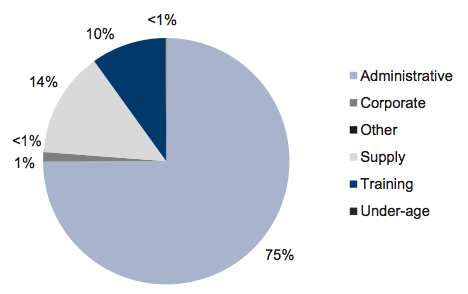
Source: Victorian Auditor-General's Office based on VCGLR data.
Only 14 per cent of breaches detected by the Compliance Unit related to the inappropriate supply of alcohol, while 75 per cent were for administrative breaches. This indicates that the Compliance Unit is not detecting the types of offences that are associated with alcohol-related harm, such as serving intoxicated persons or minors.
However, as Figure 4B shows, Victoria Police is not detecting these types of offences either. Victoria Police's emphasis has been on individual offences, rather than identifying and pursuing the licensees associated with the individual offender.
As a result, there is insufficient identification and follow-up of the sources of alcohol‑related harm. The lack of coordination has produced a gap in the enforcement framework that is limiting enforcement agencies' ability to achieve the harm minimisation objective of the Act.
Figure 4B
Victoria Police and VCGLR offences detected relating to intoxication, drunkenness and minors in 2010–11
|
Offence |
Victoria Police |
VCGLR |
Total |
|---|---|---|---|
|
Licensees |
|||
|
Serving alcohol to or allowing a minor on licensed premises |
0 |
14 |
14 |
|
Supplying alcohol to an intoxicated person |
0 |
31 |
31 |
|
Allowing a drunk person on licensed premises |
4 |
2 |
6 |
|
Supplying liquor not in accordance with licence |
15 |
860 |
875 |
|
Total |
19 |
907 |
926 |
|
Individuals |
|||
|
Minor entering a licensed premises |
13 |
0 |
13 |
|
Minor consuming or purchasing alcohol |
345 |
3 |
348 |
|
Being drunk and/or disorderly/riotous |
13 977 |
0(a) |
13 977 |
|
Failing to leave a licensed premises when drunk, violent or quarrelsome, or on request |
188 |
0(a) |
188 |
|
Total |
14 523 |
3 |
14 526 |
(a) Compliance inspectors do not have the power to issue infringements for these offences.
Note: 'Supplying liquor not in accordance with licence' includes offences such as exceeding permitted trading hours.
Source: Victorian Auditor-General's Office based on Victoria Police and VCGLR data.
Enforcing these types of offences is more challenging than enforcing administrative breaches of the Act because the police officer or compliance inspector needs to be 'in the right place at the right time' to witness the offence taking place.
Under-age offences
At present, the Compliance Unit and Victoria Police detect only a fraction of under-age offences that occur. This may be partly due to the wide acceptance of alcohol in society, which has led to inconsistencies between policy and legislation relating to under-age drinking.
According to a 2008 survey, 14 per cent of 16–17 year old secondary school students had purchased alcohol illegally. On a statewide basis, this equated to 19 971 people in 2011. However, the Compliance Unit and Victoria Police together issued just 348 infringements to minors for illegally purchasing, possessing or consuming alcohol. This is less than 2 per cent of the total number of estimated under-age purchasers. It should be acknowledged that other courses of action may have been taken that are not accounted for in these numbers, such as ordering the minor to get rid of the liquor or issuing a warning.
One of the VAAP actions was 'consider introducing under-age operatives' to test licensees' willingness to sell liquor to minors. Similar arrangements exist for tobacco. However, DOJ recommended against using under-age operatives for alcohol, as it would require legislative amendment and 'significant government expenditure'. DOJ also advised that, since the illegal purchase of alcohol by minors is primarily made with fake identification, other options should be explored.
DOJ's 2009 briefings did not quantify the sums involved, or the alternative options. DOJ also did not explain why the fake identification issue applied to alcohol but not tobacco. This is a significant missed opportunity to address the illegal supply of alcohol to minors.
The fines associated with under-age offences differ significantly between the Liquor Control Reform Act 1998, Gambling Regulation Act 2003 and Tobacco Act 1987. The penalty for a gambling provider who permits a minor to gamble is double the penalty for a licensee who supplies a minor with alcohol. The penalty for a body corporate selling a minor tobacco is 10 times higher.
DOJ has advised that consistency of message is one of the issues being explored in the new alcohol and drug strategy. The difference in fines is one example of an area that warrants a review.
Intoxication and drunkenness
There are different offences for intoxication versus drunkenness. The lack of clear guidance on these offences can present difficulties for licensees, compliance inspectors and Victoria Police when applying the Liquor Control Reform Act 1998. Successfully prosecuting licensees is also challenging due to certain conditions in the Act.
The Act defines intoxication—'a person is in a state of intoxication if his or her speech, balance, co-ordination or behaviour is noticeably affected and there are reasonable grounds for believing that this is the result of the consumption of liquor'.
However, drunkenness is not defined either in the Act or in VCGLR guidance; leaving the difference between intoxication and drunkenness open to interpretation. Licensees may be unaware that the courts have defined a drunk person as someone who has a gross or severe impairment to mental and/or physical faculties as a result of the consumption of liquor, and is so incapable of managing his/her affairs that they disregard their safety or the safety of others.
The distinction is important. It is an offence for a licensee to allow a drunk or disorderly person to be on licensed premises. However, an intoxicated person may be allowed on the premises as long as the licensee does not supply them with liquor. The maximum penalty for these offences in 2011–12 is $14 657.
Enforcing these types of offences is more challenging than administrative breaches of the Act, not only because of the subjective interpretation, but also because the Act allows a licensee to avoid prosecution if they can prove they did not know that drunken or disorderly persons were on the premises, and had taken reasonable steps to ensure that drunken or disorderly persons were not on the premises.
Licensees have been able to use this defence to avoid prosecution because they were not on the premises at the time of the offence, and their staff had completed the RSA industry training.
4.4 Compliance Unit enforcement
VCGLR's compliance model is intended to foster a culture of voluntary compliance and proactive harm minimisation.
In its first year of operation, 2009–10, the Compliance Unit inspected 83 per cent of active licences. In 2010–11, it adopted a more targeted approach, inspecting 51 per cent of licences as it focused on the premises with the greatest risk of alcohol‑related harm, based on the results of the first year of inspections.
4.4.1 Compliance model
While a key focus of the Compliance Unit is on providing education and support to licensees, there is a range of enforcement options available to the Compliance Unit for licensees that repeatedly breach their liquor licence or their obligations under the Act.
This approach is known as responsive regulation, where the action taken by the regulator depends on the level and pattern of non-compliance by the individual licensee. It is widely used by regulators to promote a compliance culture.
Figure 4C shows the enforcement actions taken over the past two financial years.
Figure 4C
Enforcement actions undertaken
|
Enforcement action |
2009–10 |
2010–11 |
|---|---|---|
|
Risk management discussions |
25 |
22 |
|
Voluntary compliance letters for relatively minor breaches |
5 103 |
1 002 |
|
Written warnings, followed up by an inspection within 3 months |
17 |
218 |
|
Penalty infringement notices |
251 |
635 |
|
Enforceable undertakings |
4 |
21 |
|
Disciplinary hearings with the Victorian Civil and Administrative Tribunal (VCAT) |
0 |
1 |
|
Criminal prosecutions |
4 |
44 |
Note: Since February 2012 responsibility for conducting disciplinary hearings has transferred to the Victorian Commission for Gambling and Liquor Regulation.
Source: Victorian Auditor-General's Office based on VCGLR data.
The Compliance Unit has key performance indicators (KPI) for the regulation of licensed premises in Victoria. Data for 2010–11 shows that the Compliance Unit:
- exceeded its target for the number of inspections by 4 per cent
- achieved its KPI for responding to complaints in 99.7 per cent of cases
- achieved a 100 per cent success rate in the criminal prosecutions initiated.
However, it did not achieve its KPIs on timeliness with regard to enforcement action. When setting the KPIs, the Compliance Unit underestimated the actual time required to initiate enforcement responses such as prosecutions and other disciplinary actions was significantly higher than expected. These KPIs have now been changed as they are largely due to factors, including the legal process, beyond the Compliance Unit's control.
Taking timely action in this area is critical. A venue that is consistently non-compliant with liquor legislation is contributing to alcohol-related harm to the community.
4.4.2 Inspection program
The compliance inspection program is having a noticeable and positive effect on licensees' compliance with administrative requirements of their liquor licence. However, the Compliance Unit is not identifying and enforcing breaches associated more directly with harm in an effective, efficient and comprehensive manner. Only 14 per cent of the breaches detected by the Compliance Unit in 2009–10 and 2010–11 related to irresponsible service of alcohol.
Figure 4D shows the number and results of compliance inspections in 2009–10 and 2010–11.
Figure 4D
Compliance Unit coverage and compliance statistics
|
Inspections and breaches |
2009–10 |
2010–11 |
Decrease |
|---|---|---|---|
|
Coverage |
|||
|
Active liquor licences at 30 June |
19 350 |
19 165 |
–1% |
|
Inspections |
26 135 |
16 724 |
–36% |
|
Licences inspected |
15 969 |
9 800 |
–39% |
|
Percentage of licences inspected |
83% |
51% |
|
|
Compliance |
|||
|
Licences with breaches |
7 463 |
2 757 |
–63% |
|
Percentage of licences inspected that had breaches |
47% |
28% |
|
|
Breaches recorded |
15 305 |
4 369 |
–71% |
|
Average breaches per inspection |
0.6 |
0.3 |
|
Note: Some licences were inspected more than once during the financial year.
Source: Victorian Auditor-General's Office based on VCGLR data.
Although the number of inspections decreased by 36 per cent, the number of breaches decreased by 71 per cent. This indicates there has been a marked improvement in compliance among those licensees inspected, although this is dependent on how appropriately the Compliance Unit has targeted its inspections.
The Compliance Unit has reviewed its practices and implemented some positive changes in streamlining its organisational structure, improving its intelligence gathering and analysis, and enhancing the training for compliance inspectors. Continuing to refine its analysis of high-risk premises as data is gathered from more inspections will improve the Compliance Unit's ability to target its inspection program.
However, despite the apparent improvement in compliance, most of the breaches detected by the Compliance Unit did not relate to irresponsible service of alcohol practices. This is partly explained by the timing of inspections in regional areas.
Carrying out inspections at quiet times can be beneficial, as there is greater opportunity for inspectors to engage with and educate licensees and industry staff. However, the scheduling of regional inspections is not striking an appropriate balance at present.
Of the total inspections carried out by the regional compliance inspectors, only 20 per cent were conducted on weekends, which is when most alcohol-related harm occurs. While metropolitan officers are rostered to work weekends, regional inspectors carry out relatively few inspections on nights and weekends.
This is due to the terms of the Victorian Public Sector Agreement that apply to the regional inspectors. These terms restrict the flexibility and increase the cost of rostering staff for weekend shifts. The Compliance Unit could have amended the employment conditions of its inspectors. It did not do so.
The current arrangements diminish the effectiveness of the inspection program and are an inefficient use of resources.
Successfully prosecuting unlawful supply is contingent on the compliance inspectors being able to gather sufficient evidence. The number of premises compliance inspectors are required to visit—16 000 in 2011–12—may impede the quality of inspections and the ability to gather this evidence.
The integration of the liquor and gambling compliance functions is an opportunity to compare and improve current enforcement practices to enhance effectiveness and efficiency.
4.5 Victoria Police enforcement
Victoria Police's alcohol enforcement activities range from major planned operations conducted in Melbourne and the large regional centres to specifically-tailored enforcement operations and educational programs to address issues in local communities.
4.5.1 Strategic and operational framework
Victoria Police's enforcement is effectively targeting antisocial behaviour by individuals, but not the source of the alcohol.
The diverse and dispersed nature of Victoria Police's responsibilities requires a clear overarching strategic and operational framework for policing alcohol-related harm to maximise effectiveness and efficiency. This framework is not in place. Victoria Police has not taken sufficient action to direct and coordinate alcohol enforcement.
Victoria Police's Taskforce RAZON business case, which was prepared in 2008, noted that 'liquor licensing and enforcement in Victoria Police has been fragmented, under‑resourced and uncoordinated for a number of years'. The business case cited low levels of penalty notices issued and VCAT applications taken against licensed premises.
In 2008, Victoria Police developed the Victoria Police Alcohol Strategy, with the aim of reducing alcohol-related crime. This strategy was described in the context of other policing and alcohol strategies and included a range of measures that were clearly aligned to its intended outcomes.
However, soon after its release the strategy was superseded by VAAP. VAAP was a high-level whole-of-government strategy and contained few actions that were directly relevant to Victoria Police. Therefore, it did not provide the same level of comprehensive strategic guidance for policing as the Victoria Police Alcohol Strategy.
Adopting VAAP did not preclude Victoria Police from developing complementary operational guidance and enhancing intelligence gathering to drive appropriate, timely and consistent enforcement activities. However, Victoria Police has taken insufficient action to address its fragmented approach to enforcement.
Responsibility for day-to-day alcohol policing is highly devolved, with local area managers and police officers determining their own enforcement activities. While it is appropriate that activities should reflect the particular circumstances and needs of a local area, the lack of strong central direction and guidance increases the risk of inconsistencies in approach and inefficiencies through duplication of effort.
Victoria Police has sought to mitigate this by developing centralised specialised units, such as the Drug and Alcohol Strategy Unit and Licensing Enforcement Division. The Drug and Alcohol Strategy Unit publishes bulletins and information booklets and runs a drug education course for police officers seeking to be qualified to deliver community or school-based education. The Licensing Enforcement Division provides training and runs covert operations.
However, these areas could do more to increase effectiveness and efficiency by:
- identifying and disseminating good practice to benefit police operations throughout the state
- improving the training for police officers on liquor enforcement
- enhancing the quality of intelligence gathering and analysis
- using more sophisticated evaluation to assess the effectiveness and cost/benefit of police operations to reduce alcohol-related crime and minimise harm.
Some of these issues may be addressed by the introduction of the Licensed Premises Prevention and Enforcement Model. Endorsed by Victoria Police Command in November 2011, the purpose of this model is to create a consistent and coordinated response to policing licensed premises in Victoria. It encourages early intervention to prevent harm in licensed premises. However, the model has not been rolled out to date.
4.5.2 Alcohol-related crime data
The number of offences relating to alcohol is under-reported. There is no mandatory protocol to record the presence of alcohol, and inefficient, duplicative processes discourage the capture of non-essential details.
Given the shortcomings in the data, researchers use a proxy measure of 'high alcohol hours' to reflect the days and times of the week where alcohol is more likely to be consumed. This allows an estimate to be developed of the number of assaults where alcohol is involved. A Victorian study showed that nearly two-thirds of assaults between 8 pm Friday to 5.59 am Saturday and 8 pm Saturday to 5.59 am Sunday were alcohol‑related.
Figure 4E shows how the number of alcohol-related assaults and infringements per 10 000 residents during high alcohol hours has increased over the past 10 years.
Figure 4E
Alcohol-related assaults and infringements in Victoria
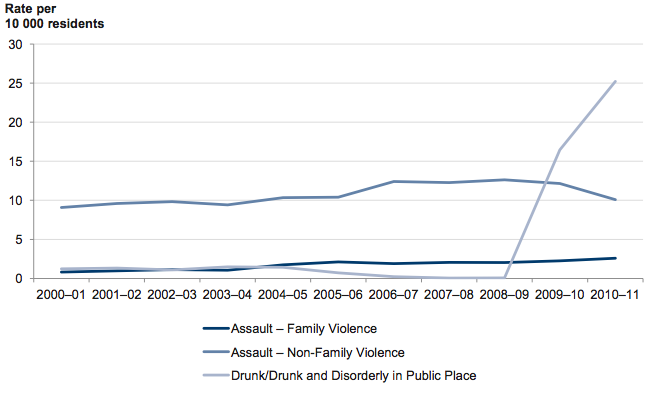
Note: Due to the addition of supplementary information to existing records, Victoria Police’s crime statistics may alter slightly over time.
Source: Victorian Auditor-General's Office based on Victoria Police data.
While the above figure is based on rates per 10 000 residents, the data on assaults reported during high alcohol hours shows that:
- The number of alcohol-related family violence offences increased by 265 per cent over the 10 years, while the number of victims increased by 105 per cent. A Melbourne-based study has demonstrated a strong correlation between the density of packaged liquor outlets and family violence. Neither DOJ nor Victoria Police can determine from the data how much of the increase is due to a change in the approach to policing family violence and how much is due to the number of actual offences increasing.
- Since 2001 there has been a 30 per cent increase in alcohol-related non-family violence.
- The overall increase in the number of alcohol-related assaults is 49 per cent.
Infringements for being drunk and disorderly in a public place and for being drunk in a public place have appeared to increase dramatically recently. Prior to December 2010 drunks were only recorded as offenders if they were also charged with other offences at the same time. This change has improved the visibility of antisocial behaviour involving alcohol.
Recording data
The information systems and processes used to record and report alcohol-related crime are antiquated, cumbersome, inefficient and incompatible with the needs of operational police.
Police officers record offence details twice—manually on the prescribed forms at the time of the incident, and then at the police station, where information is entered into police databases. There is no mandatory protocol for police officers to follow when observing and recording whether alcohol has contributed to an offence.
Law Enforcement Assistance Program
The Law Enforcement Assistance Program (LEAP) is used to record criminal offences. It provides all levels of police officers with access to information, including offenders, wanted persons and stolen property. LEAP is also the source of the crime statistics published by Victoria Police. The actual level of alcohol-related antisocial behaviour is significantly higher than reported in LEAP.
Although the Victoria Police incident form used to record assaults contains a checkbox for reporting alcohol involvement, the use of this checkbox is optional, and relies on the judgement of each individual officer. The data therefore under-represents the number of assaults in which alcohol is actually involved.
The number of incidents recorded in LEAP is materially lower than the number of incidents attended by Victoria Police. The Victorian Ombudsman found in his report Crime Statistics and Police Numbers, March 2009 that only 10 per cent of 000 calls assigned to police had a matching LEAP record.
Not all calls attended by police result in criminal offences, and are therefore not entered in the LEAP database. However, the Ombudsman also found that 'LEAP records would be unlikely for public disturbance events, which included pub brawls, people causing trouble, noise complaints and drunken behaviour'.
Further, while LEAP does allow alcohol to be recorded as a contributing factor to an offence, it is common practice for police officers to omit this detail in the LEAP data entry. Victoria Police estimates that the alcohol section is not properly completed in over 30 per cent of LEAP data entries.
Alcohol and Drug Recorded Intelligence for Tasking
Funded by a grant from the Victorian Law Enforcement Drug Fund, Alcohol and Drug Recorded Intelligence for Tasking (ADRIFT) is a 'real time' intelligence platform designed to capture the use of alcohol and/or drugs in offending. When properly utilised, ADRIFT allows the police to identify specific premises, locations and times associated with alcohol- and drug-related offending.
However, the data in ADRIFT is incomplete and its quality is not assured. Incident details are only recorded if the offender is interviewed at the police station, which may take place hours or months after the incident, depending how long it takes to apprehend the offender. Further, a complete picture of the incident is not available, as details of interviews in other locations, such as the site of incident, are not recorded in ADRIFT, and ADRIFT is only intended to record details of alcohol consumed by offenders, not by victims.
Interpose
Interpose is Victoria Police's case investigation and intelligence management system. Interpose was implemented in 2006 to target major criminal activity and the threat of terrorist incidents that raised fear of violent crime in the community. Interpose is also used to record licensed premises incidence reports.
However, Interpose is restricted in its usefulness and accessibility because:
- it is a slow web-based system using old technology on outdated hardware architecture
- operational police have limited access to the database. Officers enter details of offences but do not have access to interrogate the database for enforcement purposes—they have to request such information from analysts
- it does not link to LEAP or other enforcement recording systems used by police.
Poor quality data has restricted the effectiveness and efficiency of enforcement strategies because it has reduced Victoria Police's ability to identify particular issues and target them accordingly. Despite these limitations, there is sufficient evidence to determine that enforcement activities such as Taskforce RAZON and Operation SafeStreets have had a positive effect.
4.5.3 Taskforce RAZON
Taskforce RAZON was established as a pilot in April 2008 as part of the Licensing Enforcement Division and became a permanent fully operational unit in October 2009. RAZON has reduced the level of harm in a number of licensed premises, but more analysis is required to evaluate its overall effectiveness.
RAZON specifically targets the service of intoxicated persons, the impact of alcohol on local areas, irresponsible promotions, crowd controller performance and general compliance with licence conditions. In 2010–11, a total of 687 visits were made to 358 licensed venues throughout Victoria. RAZON focuses on high-risk licensed premises, which it identifies using a 'harm index' of crime statistics drawn from investigations, penalty notices issued and licensed premises incident reports logged in police databases.
The first annual harm index was prepared in December 2011. It classified 518 licensed premises with degrees of harm. Of these, 387 were assessed as low, 95 medium, 29 high and 7 as extreme.
While the harm index concept is relatively new and only contains data from police sources, early results indicate that it has proven successful in reducing alcohol-related harm in a number of problematic licensed premises. However, RAZON has not performed a formal evaluation of its effectiveness to date and it is unclear whether RAZON's activities have eradicated or merely displaced harm to other locations.
Including data from other sources, such as alcohol-related ambulance attendances, emergency department presentations and hospitalisations would increase the robustness of RAZON's harm index and the evaluation of its effectiveness. This could be achieved with the creation of a comprehensive, centralised multi-agency database of alcohol-related harm.
4.5.4 SafeStreets
Operation SafeStreets was established in October 2007 in response to an increase in reported assaults and antisocial behaviour. Two reviews of SafeStreets concluded that it has reduced public disorder and antisocial behaviour.
Approximately 120 police officers are deployed between 8.00 pm and 6.00 am on Friday and Saturday nights in Melbourne's CBD and surrounding suburbs. SafeStreets features:
- a highly visible police presence on foot patrol and horseback
- marked and unmarked cars
- coordination between police and council
- coordination between police and CCTV operators
- a mobile police facility.
A review by a consulting firm in June 2009 using detailed statistical analysis found that, as a consequence of increased police numbers, SafeStreets had prevented 941 offences from taking place and represented a net cost savings to the state of $7.4 million from October 2007 to February 2009.
Victoria Police carried out a second, internal review of SafeStreets in August 2011. This report found that SafeStreets had reduced public order crime and increased levels of community satisfaction with policing services in Melbourne’s CBD. The report—which is still draft—was less comprehensive in scope, detail and analysis than the first report.
Detailed harm data from both police and health sources can be used to objectively evaluate the success of enforcement actions and other strategies. Some examples of data are provided in Appendix A.
Recommendations
- The Victorian Commission for Gambling and Liquor Regulation and Victoria Police should:
- develop a comprehensive and collaborative enforcement strategy to minimise harm more effectively and efficiently
- carry out more targeted and intelligence-led enforcement activities.
- The Victorian Commission for Gambling and Liquor Regulation should implement robust, efficient and, where appropriate, consistent practices across its compliance functions.
- Victoria Police should:
- develop stronger central leadership for alcohol enforcement policy and activities
- improve the quality of the data it collects on alcohol-related crime.
- The Department of Justice should review the Liquor Control Reform Act 1998 to facilitate more effective and efficient enforcement action.
Appendix A. Consumption and harm data
Alcohol consumption and economic conditions
Affordability and availability are two of the most important determining factors of alcohol consumption levels. Figure A1 shows the correlation between changes in gross domestic product and estimates of alcohol consumption since 1960–61 in Australia.
Figure A1
Change in per capita alcohol consumption and gross domestic product in Australia
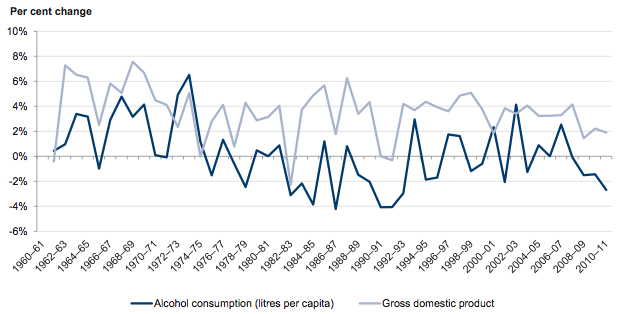
Source: Victorian Auditor-General’s Office based on Australian Bureau of Statistics data.
Data sources
When multiple regulatory or policy changes are made simultaneously, it can be difficult to isolate a directly attributable cause and effect relationship for each action. This is the case with strategies that are intended to minimise alcohol-related harm.
For this reason, it is appropriate to review a range of indicators from multiple sources to objectively assess the progress made. Since each of the data sources has its own strengths and weaknesses, the data should be considered in its entirety in order for a holistic understanding of harm to be developed.
Consumption and sales data
The World Health Organisation considers adult per capita consumption to be one of the best available indicators of alcohol-related problems. Per capita consumption of alcohol is closely linked to rates of heavy use—as rates of heavy use increase, so do alcohol-related harms. Sales data can be used to inform estimates of consumption. The Victoria-specific data produced by private market research companies is limited, and the government does not collect either retail or wholesale alcohol sales data itself at present.
Figure A2 shows the main sources of data that indicate how much alcohol people are purchasing and drinking.
Figure A2
Sources of consumption and sales data
|
Source |
Dataset |
Description |
|---|---|---|
|
Australian Bureau of Statistics |
Apparent consumption of alcohol |
Annual publication containing estimates of alcohol consumption in Australia, including consumption of different beverage types, based on imports, excise and sales data. |
|
Australian Bureau of Statistics |
National accounts (Victorian accounts) |
Annual publication containing estimates of gross state product, including estimated household expenditure on alcoholic beverages. |
|
Market research companies |
Various |
Data collected and sold by market research companies on national beverage sales trends including alcohol sales. |
|
Liquor retailers |
Retail sales data |
Data on the volume of alcohol purchased from individual retailers by customers. |
|
Liquor wholesalers |
Wholesale sales data |
Data on the volume of alcohol purchased from wholesalers by licensed retailers. |
Source: Victorian Auditor-General’s Office.
While per capita consumption levels are a useful indicator of general harm, they are not able to explain the drinking patterns of particular groups within society such as young people, or those from specific socio-economic backgrounds. This kind of nuanced information can, however, be obtained through surveys.
Surveys are an effective means of obtaining specific information on different segments of the population. They can be useful for analysing trends regarding drinking habits, attitudes towards alcohol, and incidents experienced that involved alcohol. Figure A3 shows the major surveys that contain alcohol-related data for Victoria.
Figure A3
Surveys containing alcohol data
|
Source |
Dataset |
Description |
|---|---|---|
|
Victorian Drug and Alcohol Prevention Council |
Victorian Youth Alcohol and Drug Survey |
Victorian survey conducted four times between 2002 and 2009 that measures the use of, and attitudes towards, alcohol and drugs among 16–24 year olds. |
|
Department of Health |
Population Health Survey |
Victorian survey conducted annually since 1998 on the general health and wellbeing of adults aged 18 years and older. |
|
Department of Health |
Victorian Secondary School Students’ Use of Licit and Illicit Substances |
Survey conducted every three years since 1984 on Victorian secondary students’ attitudes towards, and experience of, both legal and illegal drugs |
|
Australian Institute of Health and Welfare |
National Drug Strategy Household Survey |
National survey examining attitudes towards different drugs including alcohol, as well as usage history and related behaviour, conducted every three years. |
|
Centre for Adolescent Health |
Victorian Adolescent Health and Wellbeing Survey |
Victorian survey conducted in 2009 on the health and wellbeing of secondary school students, as well as relevant social and health issues including alcohol. Data from the survey was used in the State of Victoria’s Children 2009 report. |
|
Australian Bureau of Statistics |
National Health Survey |
National survey that has been conducted periodically since 1977–78 on a range of health-related issues including alcohol consumption. |
Source: Victorian Auditor-General’s Office.
Although surveys are an important component of the evidence base, they are subjective and, compared with statewide datasets, are based on a small and potentially unrepresentative sample of the population. They are also unable to accurately capture total harm or consumption figures—a 2001 study showed that survey data in Europe only accounted for between 39 and 56 per cent of total alcohol sales.
Harm data
Information on alcohol-related harm is available from a range of police and health datasets. The primary alcohol-related datasets are shown in Figure A4.
Figure A4
Health and police datasets
|
Type of data |
Source |
Dataset |
Description |
|---|---|---|---|
|
Ambulance attendances |
Turning Point |
Ambulance Project Database |
Alcohol- and other drug-related ambulance attendances by Ambulance Victoria in metropolitan Melbourne, compiled from patient care records completed by paramedics. |
|
Hospital admissions |
Department of Health |
Victorian Admitted Episodes Dataset |
All patients discharged from all acute hospitals in Victoria, with information on age, sex and local government area of residence and cause of admission. |
|
Emergency department presentations |
Department of Health |
Victorian Emergency Minimum Dataset |
All emergency department (ED) attendees at Victorian hospitals with 24-hour emergency departments, including demographic, administrative and clinical data. |
|
Deaths |
Australian Bureau of Statistics |
Unit Record Mortality files |
Cause of death, and details of age, sex and residential postcode of all deceased Australians. |
|
Traffic accidents |
VicRoads |
Road Network Database |
Compiled by VicRoads from Victoria Police traffic accident reports, including information on location, and vehicles and people involved. |
|
Alcohol courses of treatment |
Department of Health |
Alcohol and Drug Information System |
Details of patients attending specialist drug and alcohol treatment courses provided by community-based agencies. |
|
Offences and infringements |
Victoria Police |
Law Enforcement Assistance Program |
Details of people, vehicles and locations involved in crimes. |
Note: The Turning Point analysis contained in this report has been drawn from the above datasets.
Source: Victorian Auditor-General’s Office.
Aside from the Ambulance Project Database, which is collected specifically for the purposes of monitoring alcohol-related harm, these datasets are all secondary datasets. Secondary data is data collected for another purpose which is re-analysed. It can be a cost-effective way of obtaining large volumes of information over an extended period of time. However, using data for purposes beyond its original intention can be challenging. The non-core elements in the source data needed to perform the additional analysis are more likely to be incomplete or inaccurate. In these circumstances, proxy data may be used.
Proxy data is data that has been adapted to focus on a particular piece of information that cannot be, or has not been, directly measured. For example, the data on serious road injuries does not routinely contain information on blood alcohol concentration. However, researchers have identified the times and days of the week when the likelihood of alcohol being a contributing factor in a traffic accident is high, medium or low. These are called ‘high, medium or low alcohol hours’.
Proxy data is a useful indicator of harm, rather than an exact measure. This is because it does not take into account events that fall outside the general trend. The data is, however, useful in the absence of more precise information.
Alcohol-related harm based on age and gender
According to a 2010 survey, 14 per cent of Victorians aged 14 and over drink in a way that puts them at risk of alcohol-related injury on a weekly basis. However, levels of alcohol-related harm differ across different groups. Recently there has been increasing concern about rates of harm involving young people and women in particular.
Age trends
The number of young people consuming harmful volumes of alcohol is increasing faster than other age groups. Data from the Victorian Youth Alcohol and Drug Survey shows that the number of 16–24 year olds who had consumed 20 standard drinks or more in one day on at least one occasion within the past year increased by over 60 per cent between 2002 and 2009.
As Figure A5 shows, the number of young women drinking this amount increased by over 110 per cent during the period.
Figure A5
16–24 year olds drinking more than 20 standard drinks on one occasion
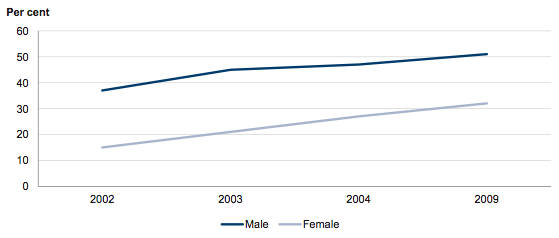
Source: Victorian Auditor-General’s Office based on Victorian Youth Alcohol and Drug Survey data.
While the numbers of people needing medical assistance for intoxication increased for all groups, Figure A6 shows the rate of the increase was significantly higher for young people than other groups.
Figure A6
Intoxication by age group
|
Age category |
2000–01 |
2009–10 |
Increase (per cent) |
|---|---|---|---|
|
Ambulance attendances in metropolitan Melbourne |
|||
|
0–24 |
431 |
1 847 |
329 |
|
25–39 |
553 |
1 510 |
173 |
|
40+ |
752 |
2 692 |
258 |
|
Age not recorded |
205 |
138 |
–33 |
|
Total |
1 941 |
6 187 |
219 |
|
Emergency department presentations in Victoria |
|||
|
0–24 |
583 |
1 694 |
191 |
|
25–39 |
748 |
1 061 |
42 |
|
40+ |
962 |
1 670 |
74 |
|
Total |
2 293 |
4 425 |
93 |
|
Hospitalisations in Victoria |
|||
|
0–24 |
491 |
1 144 |
133 |
|
25–39 |
579 |
840 |
45 |
|
40+ |
716 |
1 359 |
90 |
|
Total |
1 786 |
3 343 |
87 |
Source: Victorian Auditor-General’s Office based on Turning Point data.
These figures are particularly concerning when put into the context of population increases. The number of people aged 0–24 increased 12 per cent over the same period to 1.8 million, while the 25–39 and 40+ age groups increased 9 per cent to 1.2 million and 21 per cent to 2.5 million respectively. The rate of increase in harm far exceeds the rate of population increase.
Gender trends
Although men are more likely to be victims and/or offenders in alcohol-related harm, rates of involvement for women are not only increasing, but increasing at a faster rate than for men.
National data from the 2007 Australian Institute of Health and Welfare National Drug Strategy Household Survey shows that the number of women drinking alcohol at levels which puts them at high risk of short-term harm increased by over 10 per cent for all age groups, apart from 14–19 year olds, between 2001 and 2007.
Figure A7 shows that these trends are apparent across both health and police data. Between 2000–01 and 2009–10 the number of:
- women charged with family violence offences during high alcohol hours increased by 444 per cent
- emergency department presentations for women increased at more than twice the rate of the increase for men.
Figure A7
Alcohol-related harm by gender
|
Gender |
2000–01 |
2009–10 |
Increase (per cent) |
|---|---|---|---|
|
Ambulance attendances for intoxication in metropolitan Melbourne |
|||
|
Women |
537 |
2 169 |
304 |
|
Men |
1 383 |
4 017 |
190 |
|
Gender not recorded |
21 |
1 |
–95 |
|
Emergency department presentations for intoxication in Victoria |
|||
|
Women |
785 |
1 874 |
139 |
|
Men |
1 508 |
2 551 |
69 |
|
Hospitalisations for intoxication in Victoria |
|||
|
Women |
616 |
1 345 |
118 |
|
Men |
1 170 |
1998 |
71 |
|
Assault offences—family violence in Victoria (high alcohol hours) |
|||
|
Women |
27 |
147 |
444 |
|
Men |
365 |
1 086 |
198 |
|
Gender not recorded |
0 |
3 |
N/A |
|
Assault offences—non-family violence in Victoria (high alcohol hours) |
|||
|
Women |
563 |
946 |
68 |
|
Men |
3 740 |
5 659 |
51 |
|
Gender not recorded |
2 |
12 |
500 |
|
Drunk in a public place offences in Victoria |
|||
|
Women |
57 |
907 |
1 491 |
|
Men |
495 |
7 495 |
1 414 |
|
Gender not recorded |
0 |
30 |
N/A |
Source: Victorian Auditor-General’s Office based on Turning Point and Victoria Police data.
Case studies—local government areas
Incidents of most types of alcohol-related harm in the four local government areas (LGA) of Melbourne, Casey, Greater Geelong and Swan Hill increased between 2000–01 and 2009–10. However, road deaths during high alcohol hours did decline in three of the four LGAs during the period. The categories of harm in which individual LGAs experienced the highest levels of growth varied between the LGAs.
The number of active liquor licences also increased significantly over this time. These figures are based on data sourced from the Victorian Commission for Gambling and Liquor Regulation’s records and cleansed by VAGO.
City of Melbourne
Figure A8
Local data for Melbourne
|
Demographics |
30 June 2000 |
30 June 2005 |
30 June 2009 |
Change (per cent) |
|
Population |
48 276 |
77 382 |
93 105 |
93 |
|
Active liquor licences |
975 |
1 366 |
1 629 |
67 |
|
Alcohol-related incidents |
2000–01 |
2005–06 |
2009–10 |
Change (per cent) |
|
Assaults during high-alcohol hours |
365 |
391 |
939 |
157 |
|
Drink-driving offences |
462 |
1 000 |
930 |
101 |
|
Public order offences/infringements(a) |
20 |
15 |
2 692 |
13 360 |
|
Ambulance attendances for alcohol intoxication |
328 |
710 |
970 |
196 |
|
ED presentations for alcohol intoxication |
130 |
215 |
233 |
79 |
|
Hospitalisations for alcohol intoxication |
56 |
124 |
104 |
86 |
|
Road fatalities during high alcohol hours |
6 |
3 |
1 |
–83 |
|
Hospitalisations for alcohol-related road trauma |
29 |
25 |
23 |
–21 |
|
Alcohol-related deaths(b) |
9 |
<5 |
<5 |
N/A |
(a) Victoria Police changed its recording protocols for drunk and disorderly/drunk offences in December 2010, leading to higher numbers of offences being recorded.
(b) Includes deaths attributable to both short- and long-term harm for calendar years 2000, 2005 and 2007. Figures less than five are not reported for privacy reasons.
Melbourne has the highest number of assaults and public order offences of all LGAs. However, while Melbourne’s population is less than 100 000, the council estimates it can have over 300 000 visitors at night.
|
Black dot |
Active liquor licences granted on or before 30 June 2000. |
|
Dark blue dot |
Active liquor licences granted between 1 July 2000 and 30 June 2005. |
|
Light blue dot |
Active liquor licences granted between 1 July 2005 and 30 June 2009. |

Source: Victorian Auditor-General’s Office based on Victorian Commission for Gambling and Liquor Regulation, Turning Point and Australian Bureau of Statistics data.
City of Casey
Although Casey is one of the fastest growing LGAs in Victoria, the growth in incidents of alcohol-related harm increased even faster. In particular, there were large increases in the number of residents requiring medical attention for intoxication. The increase in the number of ambulance attendances was higher in Casey than the other LGAs.
Figure A9
Local data for Casey
|
Demographics |
30 June 2000 |
30 June 2005 |
30 June 2009 |
Change (per cent) |
|
Population |
173 642 |
216 257 |
247 357 |
42 |
|
Active liquor licences |
139 |
196 |
263 |
89 |
|
Alcohol-related incidents |
2000–01 |
2005–06 |
2009–10 |
Change (per cent) |
|
Assaults during high-alcohol hours |
116 |
269 |
281 |
142 |
|
Drink-driving offences |
428 |
678 |
640 |
50 |
|
Public order offences/infringements(a) |
4 |
7 |
108 |
2 600 |
|
Ambulance attendances for alcohol intoxication |
40 |
136 |
242 |
505 |
|
ED presentations for alcohol intoxication |
37 |
107 |
155 |
319 |
|
Hospitalisations for alcohol intoxication |
57 |
74 |
138 |
142 |
|
Road fatalities during high alcohol hours |
5 |
5 |
3 |
–40 |
|
Hospitalisations for alcohol-related road trauma |
77 |
103 |
100 |
30 |
|
Alcohol-related deaths(b) |
15 |
20 |
24 |
60 |
(a) Victoria Police changed its recording protocols for drunk and disorderly/drunk offences in December 2010, leading to higher numbers of offences being recorded.
(b) Includes deaths attributable to both short- and long-term harm for calendar years 2000, 2005 and 2007.
|
Black |
Active liquor licences granted on or before 30 June 2000. |
|
Dark blue |
Active liquor licences granted between 1 July 2000 and 30 June 2005. |
|
Light blue |
Active liquor licences granted between 1 July 2005 and 30 June 2009. |

Source: Victorian Auditor-General’s Office based on Victorian Commission for Gambling and Liquor Regulation, Turning Point and Australian Bureau of Statistics data.
City of Greater Geelong
Greater Geelong is the second most populous LGA in Victoria. Rates of emergency department presentations and hospitalisations for intoxication more than doubled between 2000–01 and 2009–10, in spite of relatively moderate population increases during the period. The number of liquor licences increased three times faster than the population.
Figure A10
Local data for Greater Geelong
|
Demographics |
30 June 2000 |
30 June 2005 |
30 June 2009 |
Change (per cent) |
|
Population |
191 459 |
203 276 |
216 330 |
13 |
|
Active liquor licences |
444 |
588 |
658 |
48 |
|
Alcohol-related incidents |
2000–01 |
2005–06 |
2009–10 |
Change (per cent) |
|
Assaults during high-alcohol hours |
200 |
228 |
324 |
62 |
|
Drink-driving offences |
440 |
847 |
633 |
44 |
|
Public order offences/infringements(a) |
15 |
18 |
419 |
2 693 |
|
Ambulance attendances for alcohol intoxication(b) |
N/A |
N/A |
N/A |
N/A |
|
ED presentations for alcohol intoxication |
73 |
137 |
153 |
110 |
|
Hospitalisations for alcohol intoxication |
58 |
113 |
120 |
107 |
|
Road fatalities during high alcohol hours |
8 |
5 |
3 |
–63 |
|
Hospitalisations for alcohol-related road trauma |
86 |
93 |
72 |
–16 |
|
Alcohol-related deaths(c) |
36 |
34 |
35 |
–3 |
(a) Victoria Police changed its recording protocols for drunk and disorderly/drunk offences in December 2010, leading to higher numbers of offences being recorded.
(b) Ambulance data was not available for Greater Geelong.
(c) Includes deaths attributable to both short- and long-term harm for calendar years 2000, 2005 and 2007.
|
Black |
Active liquor licences granted on or before 30 June 2000. |
|
Dark blue |
Active liquor licences granted between 1 July 2000 and 30 June 2005. |
|
Light blue |
Active liquor licences granted between 1 July 2005 and 30 June 2009. |
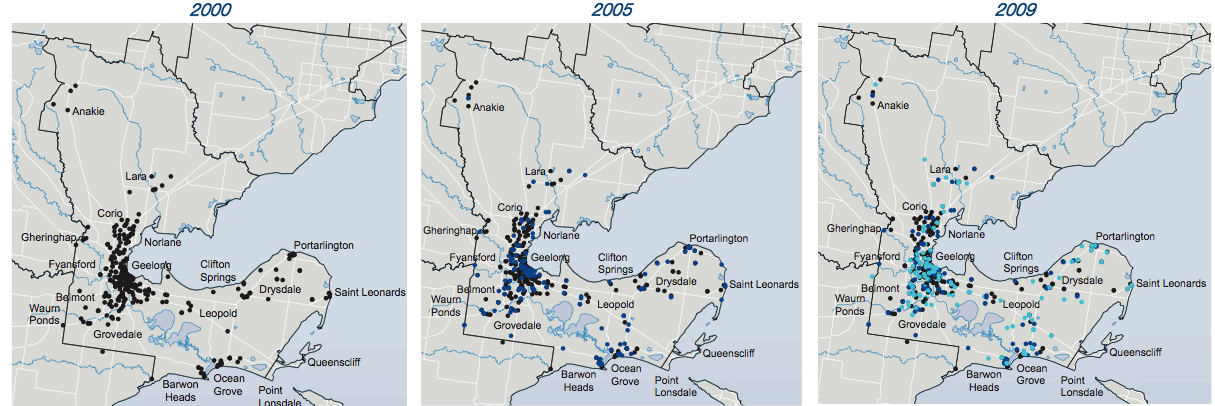
Source: Victorian Auditor-General’s Office based on Victorian Commission for Gambling and Liquor Regulation, Turning Point and Australian Bureau of Statistics data.
Swan Hill Rural City Council
The number of liquor licences in increased five times faster than the population between 2000–01 and 2009–10. The liquor outlets are primarily located in Swan Hill and Robinvale. While the number of emergency department presentations for intoxication increased, the number of hospitalisations for alcohol intoxication decreased, indicating that there were less people who required serious medical interventions for intoxication in 2009–10 than in 2000–01.
Figure A11
Local data for Swan Hill
|
Demographics |
30 June 2000 |
30 June 2005 |
30 June 2009 |
Change (per cent) |
|
Population |
21 107 |
21 319 |
22 116 |
5 |
|
Active liquor licences |
96 |
119 |
122 |
27 |
|
Alcohol-related incidents |
2000–01 |
2005–06 |
2009–10 |
Change (per cent) |
|
Assaults during high-alcohol hours |
64 |
54 |
96 |
50 |
|
Drink-driving offences |
94 |
132 |
161 |
71 |
|
Public order offences/infringements(a) |
12 |
8 |
154 |
1 183 |
|
Ambulance attendances for alcohol intoxication(b) |
N/A |
N/A |
N/A |
N/A |
|
ED presentations for alcohol intoxication |
6 |
16 |
10 |
67 |
|
Hospitalisations for alcohol intoxication |
17 |
18 |
8 |
–53 |
|
Road fatalities during high alcohol hours |
0 |
2 |
1 |
N/A |
|
Hospitalisations for alcohol-related road trauma |
5 |
8 |
9 |
80 |
|
Alcohol-related deaths(c) |
5 |
<5 |
<5 |
N/A |
(a) Victoria Police changed its recording protocols for drunk and disorderly/drunk offences in December 2010, leading to higher numbers of offences being recorded.
(b) Ambulance data was not available for Swan Hill.
(c) Includes deaths attributable to both short- and long-term harm for calendar years 2000, 2005 and 2007. Figures less than five are not reported for privacy reasons.
|
Black dot |
Active liquor licences granted on or before 30 June 2000. |
|
Dark blue dot |
Active liquor licences granted between 1 July 2000 and 30 June 2005. |
|
Light blue dot |
Active liquor licences granted between 1 July 2005 and 30 June 2009. |
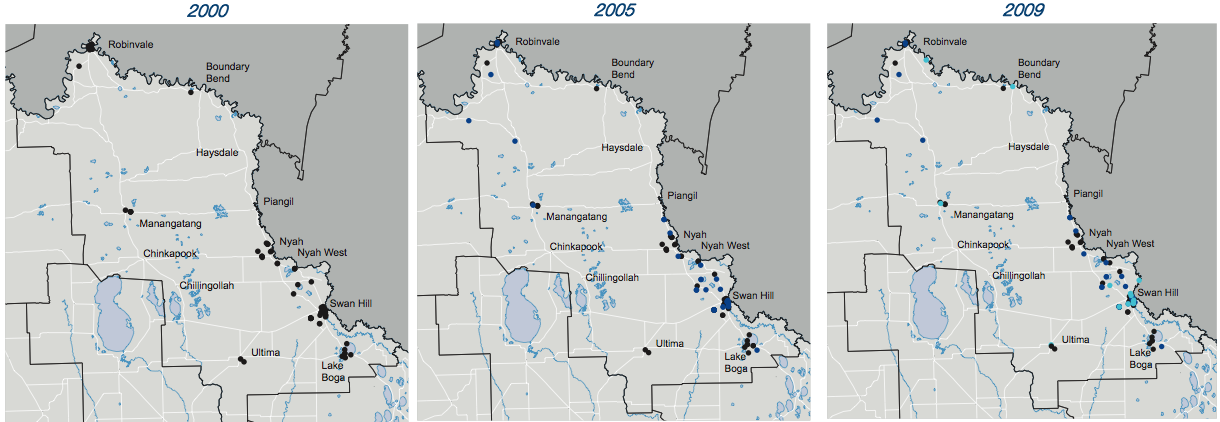
Source: Victorian Auditor-General’s Office based on Victorian Commission for Gambling and Liquor Regulation, Turning Point and Australian Bureau of Statistics data.
Appendix B. Audit Act 1994 section 16—submissions and comments
In accordance with section 16(3) of the Audit Act 1994 a copy of this report was provided to the Department of Justice, Victoria Police, the Victorian Commission for Gambling and Liquor Regulation, the Department of Health, the Department of Planning and Community Development, the City of Casey Council, the City of Greater Geelong Council, the City of Melbourne Council and Swan Hill Rural City Council with a request for submissions or comments.
The submission and comments provided are not subject to audit nor the evidentiary standards required to reach an audit conclusion. Responsibility for the accuracy, fairness and balance of those comments rests solely with the agency head.
Responses were received as follows:
- The Department of Justice
- Victoria Police
- The Victorian Commission for Gambling and Liquor Regulation
- The Department of Planning and Community Development
- The Department of Health
- Swan Hill Rural City Council
- City of Greater Geelong Council
Further audit comment:
- Acting Auditor-General’s response to the Department of Justice
- Acting Auditor-General’s response to the Victorian Commission for Gambling and Liquor Regulation
- Acting Auditor-General’s response to the Department of Health
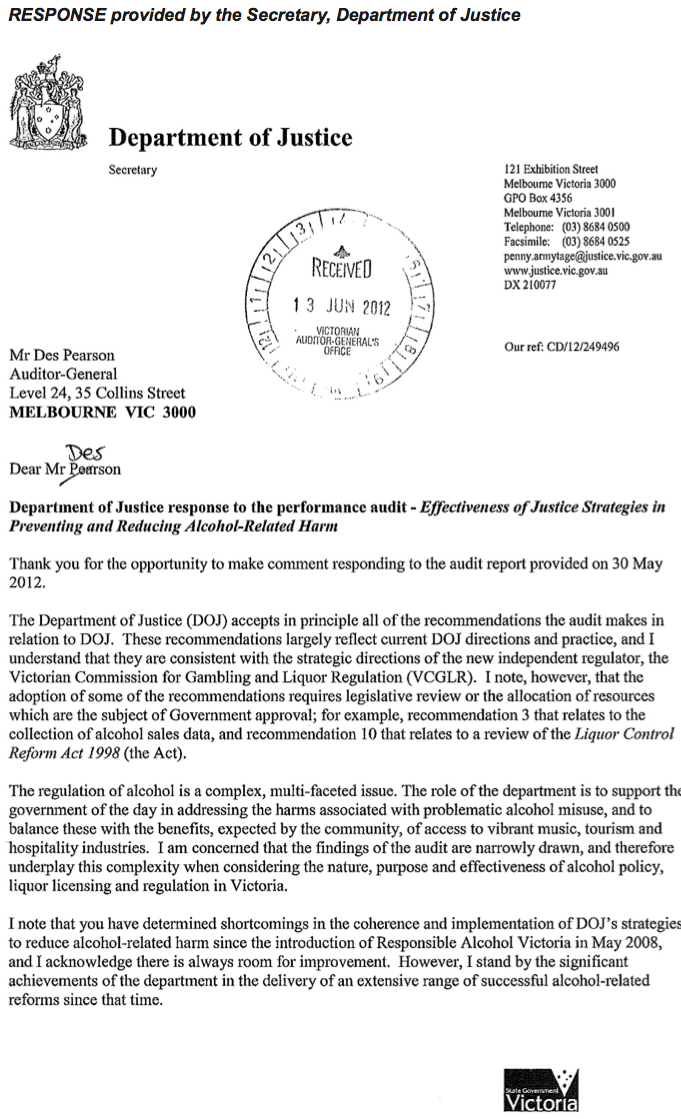
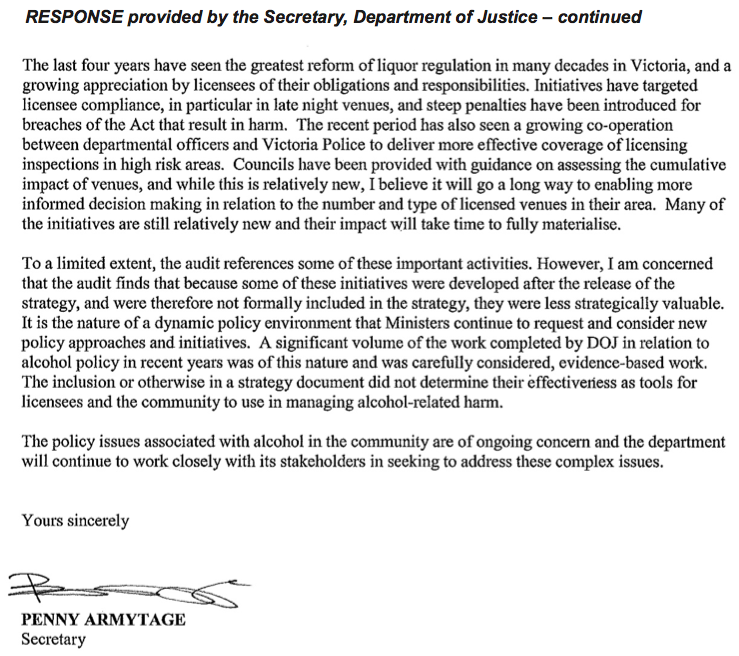
Acting Auditor-General’s comment on the response from the Department of Justice
Paragraph 3—the complexity of alcohol policy, liquor licensing and regulation.
The Secretary of the Department of Justice is concerned that the audit findings underplay the complexity of alcohol policy, liquor licensing and regulation. Yet these complexities are clearly noted throughout the report and were taken into consideration when the audit findings and recommendations were being developed.
On page vii of the audit summary, the second paragraph of the audit conclusion recognises that:
‘Combating alcohol-related harm is challenging and costly. The underlying causes are complex and there are numerous public and private sector stakeholders involved, many with competing interests. Although alcohol can be harmful, over 80 per cent of adults drink. Some types of licensed premises have a stronger association with alcohol-related harm than others. This presents significant challenges for agencies in policy and strategy development’.
Pages 7, 8, 10, 14 and 15 describe how the differing perspectives of the licensed hospitality and tourism industries, health, community and justice sectors present challenges for strategy development.
On page viii, the report notes that:
‘Since 2009, the primary objective of the Liquor Control Reform Act 1998 has been to minimise alcohol-related harm. However, the Act also requires liquor licensing decisions to take into account community expectations and responsible industry development. There is inevitably tension between these competing interests’.
Pages 6 and 25–30 expand further on the regulatory processes that aim to balance the objectives of the Act.
Paragraph 6—initiatives developed after the release of the strategy.
The Department of Justice has asserted that the audit report considers the initiatives that were not included in the strategy were ‘less strategically valuable’. VAGO disagrees.
The audit report notes that:
- some of the initiatives developed outside the strategic framework have been effective—page 15
- the main reason why these initiatives were implemented outside the strategic framework was because the strategy was seriously flawed—pages 14–15
- ‘It is to be expected that unforeseen issues will arise and require a rapid response. However, because the initiatives implemented were not part of a strategy, they were not subjected to a robust assessment or cost/benefit analysis to determine whether they were not only feasible but also the most effective and efficient use of resources.’—page 20.
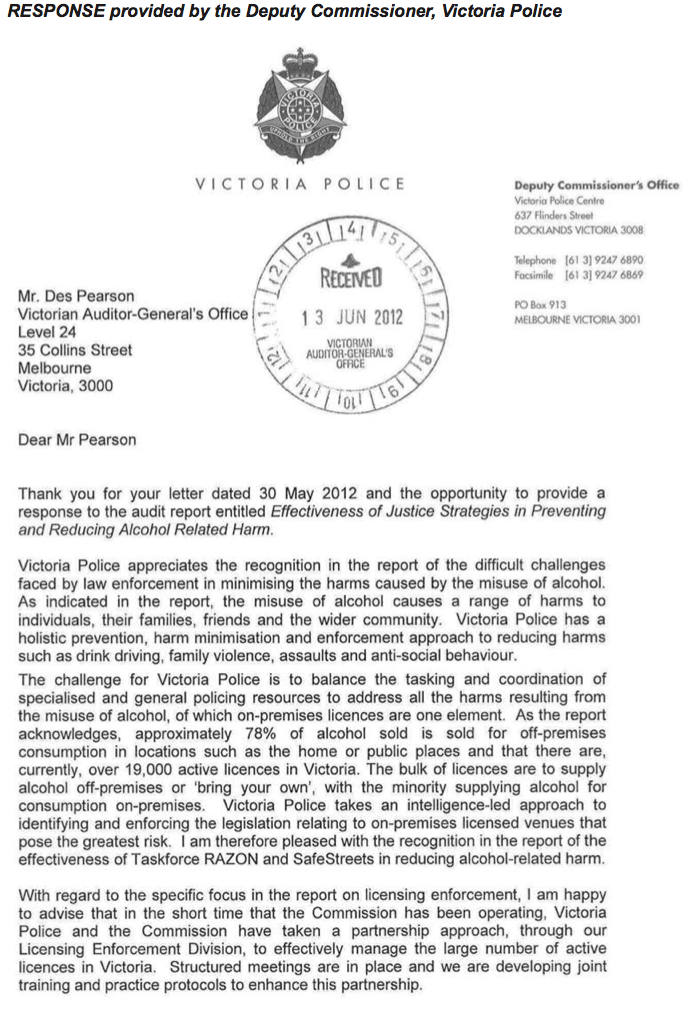
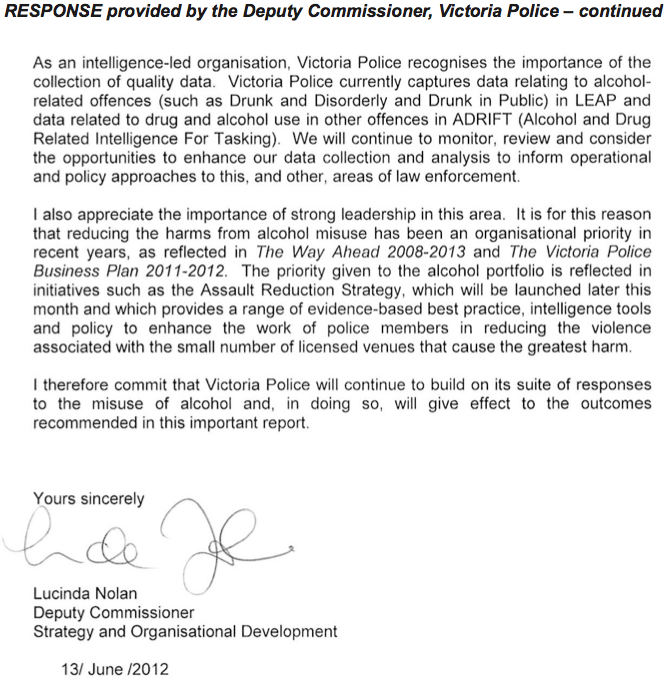
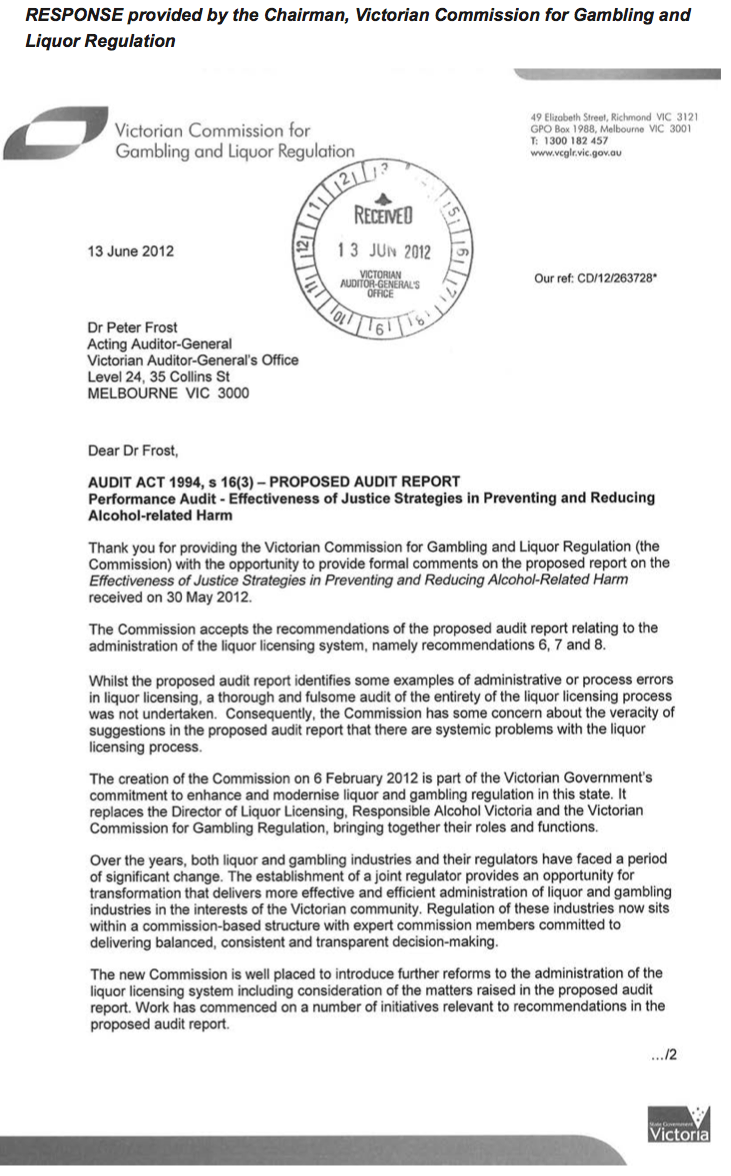
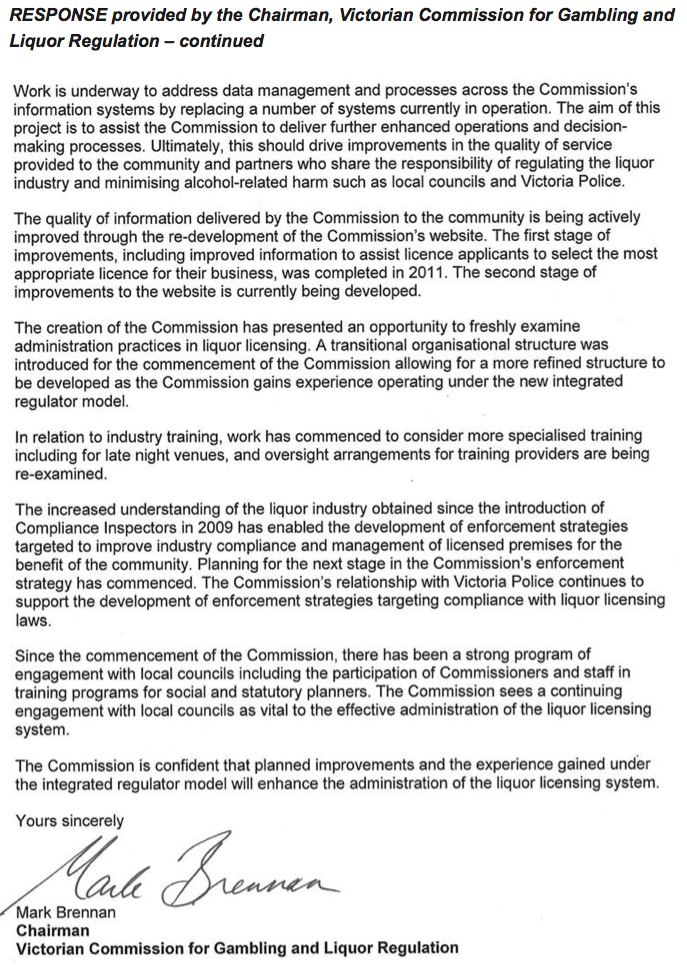
Acting Auditor-General’s comment on the response from the Victorian Commission for Gambling and Liquor Regulation
Paragraph 3—systematic problems with the liquor licensing process.
The Victorian Commission for Gambling and Liquor Regulation (VCGLR) is questioning the veracity of audit findings because VAGO did not ‘…conduct a thorough and fulsome audit of the entirety of the liquor licensing system…’. To conduct such an audit would require an examination of all 19 000 active liquor licences. This is a manifestly unreasonable expectation.
The audit has identified several instances of errors in the liquor licensing process. As the report states, it is not possible for either VAGO or VCGLR to establish how systemic the problems are because of weaknesses in VCGLR’s systems and processes. VCGLR first needs to review its licensing administration practices and improve its record management and data integrity, as the audit recommends.
Page 24 notes that:
‘The liquor licensing and planning permit application processes do not sufficiently reflect community concerns. There are also many instances where licences have been granted inappropriately—albeit not illegally—due to inconsistencies and weaknesses in the licensing regime. It is not possible to reliably quantify the extent of the issue due to the antiquated IT systems and the inaccurate, incomplete records VCGLR has inherited from the Department of Justice’.
Pages 30–32 further amplify these issues.
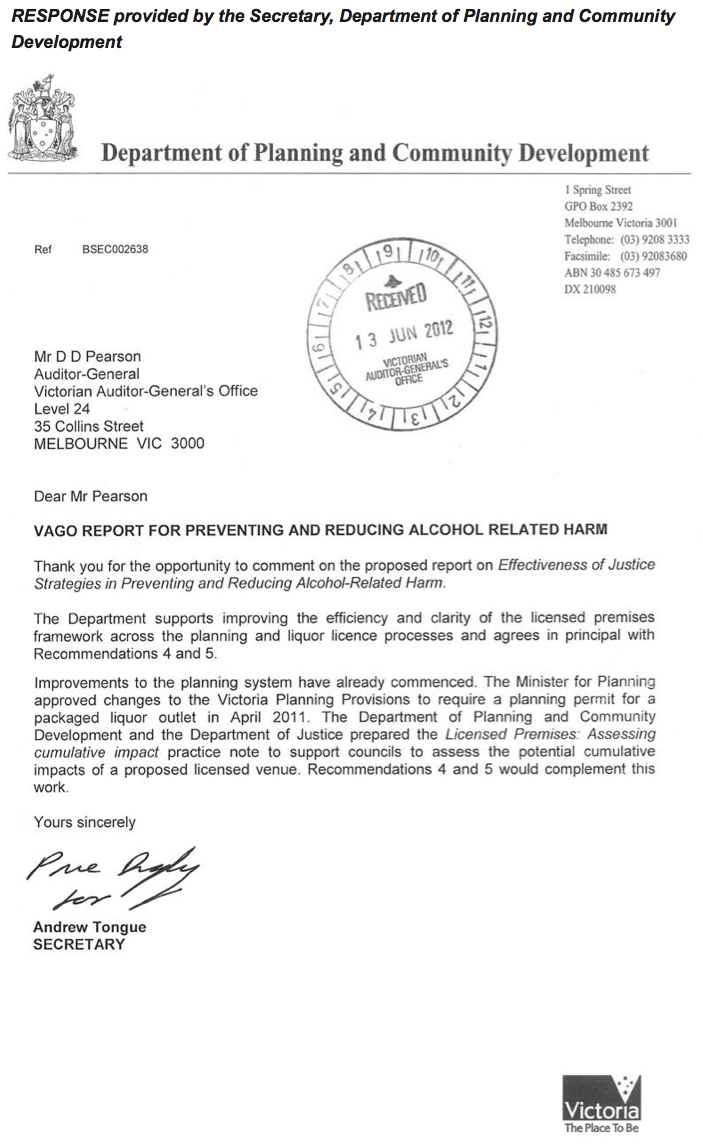
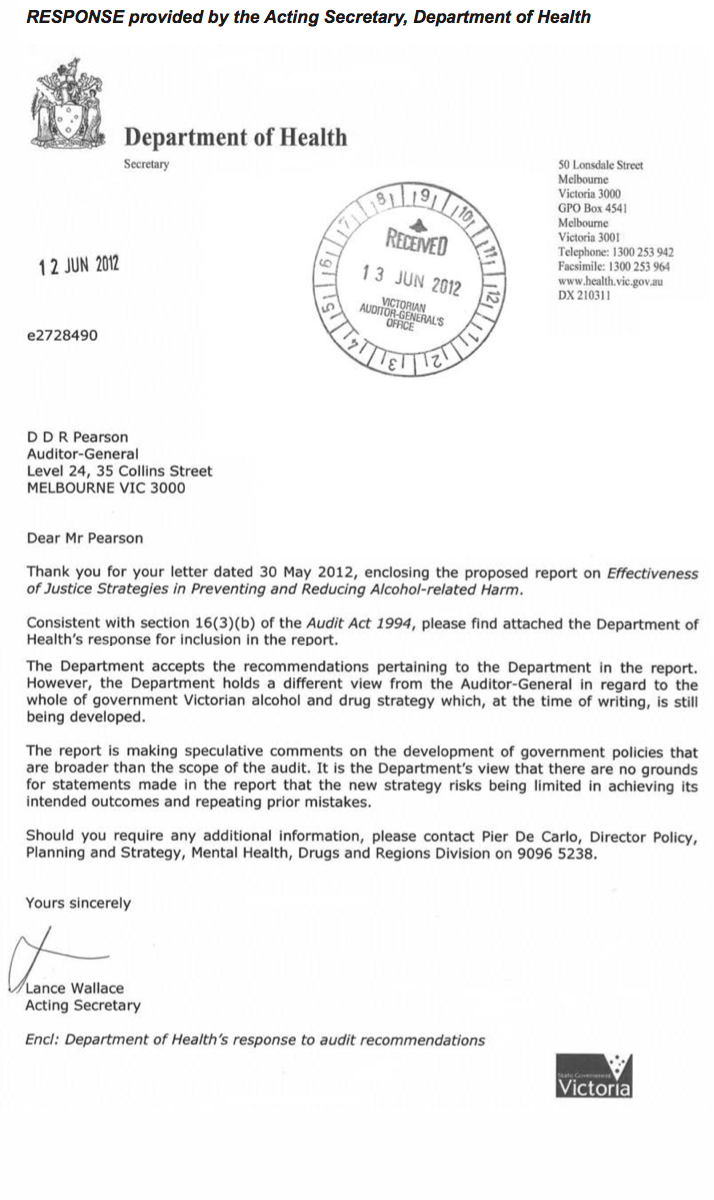
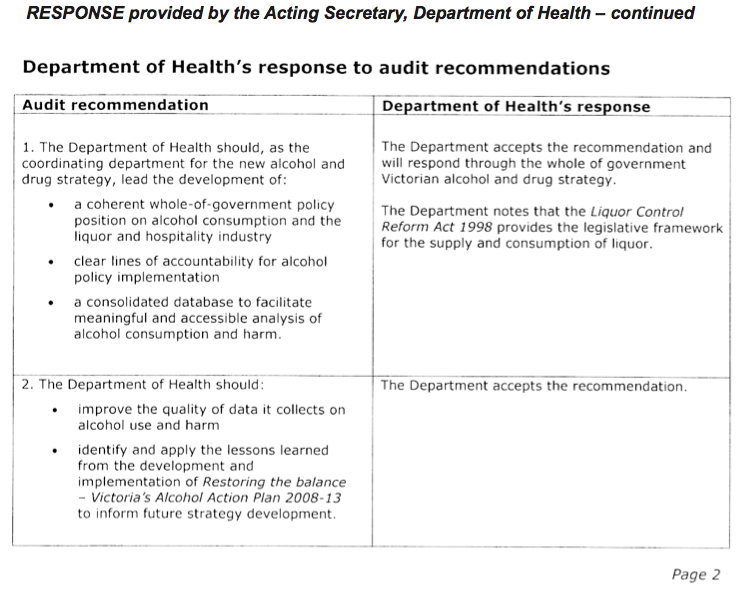
Acting Auditor-General’s comment on the response from the Department of Health
Paragraph 4—the new alcohol and drug strategy
The Department of Health has described VAGO’s finding that the new strategy risks being limited in achieving its intended outcomes and repeating prior mistakes as ‘speculative’. VAGO disagrees. The audit makes the following evidence-based observations to support this finding:
- The lack of a whole-of-government position on alcohol resulted in a diluted and disjointed strategy in 2008. No statement of policy has been endorsed to date—pages ix and 14–15.
- There was insufficient data available on consumption patterns and alcohol‑related harm to comprehensively and objectively inform the development of the 2008 strategy. There are still gaps and quality issues in the data—pages ix, x, 16–17.
- Identifying and applying lessons learned is a fundamental principle of better practice project management. The inadequate evaluation of Restoring the Balance: Victoria’s Alcohol Action Plan 2008–13 was a missed opportunity in the development of the new strategy—pages ix and 21–22.
VAGO notes that the Department of Health accepts the recommendation to identify and apply the lessons learned from the development and implementation of Restoring the Balance: Victoria’s Alcohol Action Plan 2008–13.
